#i don't care if you like my posts or my threads
Explore tagged Tumblr posts
Text
This year has, so far, been for me a series of rapid realizations of what I have been unlearning.
I went to the library. This was a couple weeks ago. I knew I needed to read a book, fiction. I hadn't done so in over a year and it was the longest period of time I had ever gone without doing so. I made a rule: I would only pick books I had never heard of, by authors I had never heard of, and I would not do any preliminary research or even bother to look at what the book was about. I would make my decision on whether to read or not purely on my impression of the title, cover and opening lines.
The book was The Connoisseur by Evan S. Connell. It was kind of a random selection. I sat down with it in a corner of the library and straight up devoured it. I tore through the book within a few hours, without taking a single break. I was captivated. I couldn't put it down.
It is a book about a guy who buys a Mayan figurine in a knickknack shop while he's on a business trip. and becomes obsessed with pre-Columbian sculptural art. There isn't really much of a plot apart from this. He goes to sketchy antique shows, has conversations with museum curators, wealthy art dealers and forgers, and seeks to learn how to distinguish a genuine pre-Columbian piece from a fake one. It was written in the 1970's, so the views on Native Americans are antiquated and sometimes offensive, and there is the troubling thread of the very concept of looting another culture's treasures and treating them as collectibles, though the book is not without commentary on this.
All the same, it was a completely intoxicating read. The vicarious experience of becoming fascinated with a topic and having it unfold a whole world for you was ferociously gripping, and so was the intrigue of the art collecting world itself. The frauds, forgeries, smuggling, museums, academics, aristocrats, auctions and seedy flea markets. Will he ever be able to tell if a piece is "real?" Does it matter if it's "real?" Why does he want to own and possess a piece of art, and how does its "realness" affect that desire? The book leaves you not knowing what to think.
It is a book about curiosity, portrayed in the narrative as a totally unreasonable lightning bolt that strikes a man who has never been fascinated by anything and changes him forever. Why? Why does a Mayan figurine, in particular, speak to him? Why does any piece of art, or any fascinating thing in the world, speak to anyone? It is unknowable.
I went to the library again. I picked a new book using the same rules. This book was Fragile Beasts by Tawni O'Dell. Just like the last time, I was totally captivated. I couldn't put it down.
Did I have a couple major problems with the portrayal of some important aspects of the story? Yes. (It would make the post much longer to discuss.) Was I completely captured by and invested in the story for the time I was reading it? Also yes. The book braids together several very different strands-- the story of a legendary Spanish bullfighter and a wealthy American woman that he loved, two brothers stuck in an ugly family situation after their father's death in a car accident, and a rich old heir to a Pennsylvania coal mining fortune and to the sinister underbelly of her family's business.
There was a lot about baseball, which I know nothing about, and bullfighting, which I know nothing about, and I certainly don't know anything about being a teenaged boy who resents and mistrusts his estranged mother, or an aristocratic old lady who lives in a mansion and eats fancy Spanish food. It was fun to experience so much unfamiliar stuff and to care about things I wouldn't normally care about. Once again I couldn't stop reading until I had finished it.
I don't know that either book was "good," though I thought they were both well written; I just know that reading them was like being hooked up to an IV of something essential and life-giving and feeling it reanimating my body.
It had been a year since I had read any fiction, but it had been much, much longer since I had loved to read. As I became an adult I had become picky and critical about books, and developed a highly sophisticated sense of my taste and the books I considered good- which were very rare. My taste in books became so sophisticated, eventually, that I didn't like books at all anymore.
I had almost withered away from deficiency of that essential nutrient known as STORY. I'd almost crumbled myself into dust from pretentiousness! I may have been terribly wrong about the kinds of things I liked to read, on top of it. And I certainly hadn't realized that story was such an essential nutrient.
"Just entertainment" the pretentious sorts of people might say of a book they think is useless-- but what is entertainment but to absorb your mind in something, and what is absorbing your mind in a book but to experience things you would never have experienced? It expands you and makes you more complicated. It is the study of human existence itself.
Now all I have been able to think about today is finishing my work and going to the library again...
494 notes
·
View notes
Text
The older I get, the more I understand old people who wilfully refuse to learn new things. If it's important for my survival or will make things easier, I'll give it a go, but I'm not learning what the latest social media thing is or what a game franchise that doesn't interest me actually is. I only have brain space for so much, and some of it is reserved for stuff I passively absorb and then have no idea how I know it.
#eg i still don't really know what final fantasy is and don't care to#i have learned some things against my will and prefer not to have#I'd like to delete anything i know about bitcoin or blockchain or whatever because it's the dullest shit#this post brought to you by 'what is Threads? never mind i don't care'
15 notes
·
View notes
Text
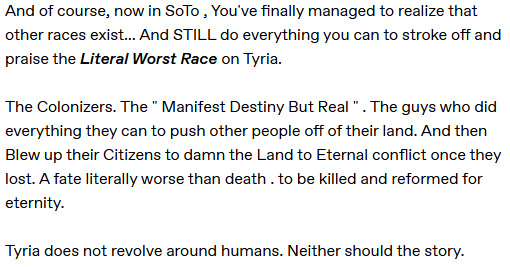
oh i'm sorry, i didn't realize we were taking moral standing points from the asura now. y'know. the race that full-hog experimented and ripped apart sylvari even after knowing they were wholly sapient beings (and it wasn't even inquest! it was regular fucking asura! the arcane council most definitely okayed those experiments! never mind the fact that the council TO THIS DAY fucking openly allows inquest to do as they please so long as they don't cause trouble in rata sum) and have done little to nothing to apologize for that fact to their sylvari allies.
but no, you're right, the humans are the worst race in tyria just by way of existing and trying to find a place for themselves. how could i have ever thought different?
#from beyond the grave#hi i'm going to go fucking feral#I'M NOT EVEN A HUGE HUMAN FAN. i have them and i love the ones i do have! but i greatly prefer sylvari as my playable race.#what the FUCK are you talking about#“did everything they can to push other people off their land” are you talking about pushing charr out???? cus uh.#i don't know how to tell you this but the charr STOLE THAT LAND IN THE FIRST PLACE EVEN BEFORE HUMANS#dont even get me started on their HoT take (the One Expansion that anet gave sylvari before forgetting they exist)#and the icebrood one (the charr should have never been the fucking main focus of the goddamn NORN PLOT ANYWAYS)#the “human interference” in icebrood was literally a fucking BLIP amongst the bullshit of the charr getting involved#don't even fucking talk to me about “humans being lynchpins” for icebrood. it should have had NOTHING but NORN LORE.#it was the NORN PLOT. jormag had always been NORN STORY AND PLOT.#“buhbuhbuh humans” I DON'T GIVE A SHIT. THE CHARR SHOULDN'T HAVE BEEN THERE EITHER#it's extremely telling that you don't care that the charr shouldn't have been there either#and only focused on the .0000000000003 seconds that kas helped in anything related to the plot#while also framing crecia and rytlock's relationship problems throughout as “human-looking” squabbling#god forbid rytlock get some character development where he WANTS TO TAKE RESPONSIBILITY for his kid#(even tho it should've happened in a charr-centric story thread and NOT THE FUCKING NORN ONE ANET)#and every charr in the world is like “but why do you care??” because charr society is so incredibly FUCKED re: their kids#“being attentive to the story” my fucking ass. just say you fucking hate humans as a race and move the fuck on.#i didn't mean to rant this much in the tags but the more i stared at the post the more i felt like biting someone#OH. OH SORRY. i just noticed that#the person was like “lol inquest figured out how to harness elder dragon energy before xunlai <3”#JUHGTFJHKDFJHGLKFD ??????#okay for one the inquest are a bunch of literal rat bastards who caused a NUCLEAR REACTOR EXPLOSION in metrica#i'm not going to trust a fucking inquest ANYWHERE NEAR ME let alone praise them for “ethical” dragon energy#the “uhm ACKSUALLY S W E A T Y” tone of voice re: canthan tech vs. asuran is asinine and also annoying as fuck#“all of PoF was about humans :(” IT IS LITERALLY. ABOUT A HUMAN GOD? IT IS *THE* HUMAN XPAC.#IT WAS NOT A SURPRISE FOR IT TO BE HUMAN THEMED? WE KNOW ELONA IS H U M A N S ?#yet again. what the FUCK are you even talking about.#OKAY. jesus christ. i think i'm finally done bitching about this.
10 notes
·
View notes
Text
Great additions! I completely missed that line from Jinx re: the chembarons but that's super interesting. I guess it makes sense that Silco wouldn't have immediately taken over the Lanes after Vander died, but had to deal with the infighting first, and he did that by essentially making them all absurdly rich. Part of that is flooding the Lanes with Shimmer, creating a new lucrative trade opportunity, and part of that is having free access to the Hexgates via Marcus for various other illegal shipments. The alliance between him and the chembarons definitely feels strained and uneasy, and although it sounds like Finn was loyal to him from quite early on ("when you took Vander out of play, I thought, 'now here's the man who understands what it takes to run an enterprise'"), he's quick to turn on him as soon as profits start plummeting.
I agree with the idea that the mines weren't necessarily the only option, and one of my biggest backstory headcanons for Silco is that he started out as a dockhand when he was fairly young before he got sent down to the mines. I like the idea that he spent his earliest formative years working for and in the vicinity of Topsiders, since that would explain his comparatively posh accent in contrast to characters like Vander and Benzo. Plus the water theming fits so well with his character.
Regarding the Kirammans' ventilation system, I really like the theory in this post. TL;DR Silco is known to Topsiders by name - as "the industrialist" to Cait in S1E5 and a former person of interest to the council in S1E8 - which is odd for someone from Zaun, and suggests that he might have had been pulling some strings behind the scenes to manipulate council members into enacting change in Zaun. This particular theory, of course, is that he brought the issue of Zaun's pollution to the council's awareness, and Cassandra Kiramman took action on it. Alternatively, the League lore page for Piltover mentions that the Grey is on the rise and is starting to seep into Piltover in some areas, so I could very plausibly believe that they suddenly began to care about it when it was a problem for them. That could have definitely been a byproduct of Silco's mass production of Shimmer. We do see a lot more clean air/ventilation facilities around the Lanes under Silco's reign than we did in Vander's Zaun, if you look closely at the Dirty Little Animals sequence in S1E4, so I don't think he was just letting the Grey run rampant without providing at least some semblance of a solution. It does seem like his priority was on clearing the air rather than waterways though, which is interesting given his own personal experiences.
Crime lord Vander is also an interesting theory and I did stumble across one forum thread that discussed something along those lines. In S1E1, Benzo talks to Vander about "rounding up the collections", and some people theorised that this could refer to protection money, which may imply a sort of mafia-like structure to the Underground during the era of Vander's solo leadership. Even if that wasn't the case in the canon timeline, that could have been a path he took (or intended to take) early on. I definitely think Vander was a very brutal and scary man in his youth based on his title of "Hound of the Underground", but it's hard to know how much of his brutality was directed at Topsiders and how much was channelled into the conflicts within his own people. I'm inclined to believe the Day of Ash was the biggest and deadliest riot they incited against Piltover, if not the only one.
Piltover and Zaun Lore Deep Dive
I've been doing extensive research into the history of P&Z for a Silco and Vander origin story fic, and I figured it could be helpful to share my findings here too!
My main goal was to try and integrate known Arcane lore with League lore and iron out some of the creases, to nail down exactly what the world of P&Z looked like in Arcane. I've done a lot of extrapolating and theorising to make sense of it all, but if you're just interested in the raw data from canon, I've compiled all my notes on a Google Doc. All sources are listed throughout.
The contents of this post are as follows:
Part 1: Chronology (the timeline)
Part 1.1: Chronology in League of Legends
Part 1.2: Chronology in Arcane
Part 1.3: Integrating the timelines
Part 2: Geography (the layout of P&Z)
Part 2.1: Existing maps of Piltover and Zaun
Part 2.2: Geography in League of Legends
Part 2.3: Geography in Arcane
Part 2.4: Integrating the layouts
Part 3: Modern Zaun (ft. Silco and Vander)
Part 3.0: Preamble
Part 3.1: The timeline of Zaun’s creation
Part 3.2: Vander and Silco’s early life
Part 3.3: Golden age of Vander and Silco
Part 3.4: After the betrayal
Part 4: Wrap-Up
Summary of the timeline
~~~
Part 1.1: Chronology (League of Legends)
Information derived from the LoL Fandom Wiki and official LoL website, with most details corroborated by various Reddit threads and similar forums. BN means Before Noxus, and AN means After Noxus.
6000-5000 BN: Westward Migration. Humans began to migrate from the eastern hemisphere to the western hemisphere, towards the Shuriman Continent. Settlers founded many new nations and cities. Among these was a sea port called Oshra Va’Zaun (also referred to in some places as Osha Va’Zaun or Kha’Zhun, but I went with what was most consistently used on the Wiki). Oshra Va’Zaun connected the Shuriman Continent to Valoran via an isthmus, or artificial land bridge, that allowed for free trade between the continents and also comprised docks from which sailors could travel in and out. The people of Oshra Va’Zaun worshipped Janna (then known as Jan’ahrem), the wind spirit. As a spirit god, she relies on prayers to keep her strong. Sailors and merchants would pray for calm seas, and she would deliver.
2000-3 BN: Various Wars. The fall of the Shuriman Empire (2000 BN), the Darkin War (550 BN) and the Rune Wars (25-3 BN) all took place during this time. Janna protected Oshra Va’Zaun from every conflict, preventing it from becoming rubble.
772 AN: The Collapse. The people of Oshra Va’Zaun planned to destroy a portion of the isthmus connecting Valoran and the Southern Continent, allowing for safe sea passage between eastern and western Valoran. The plan was to use thousands of Chemtech bombs to crack open an area of the land so that a cavern could be created. Instead, the bombs triggered a series of earthquakes that completely destroyed the isthmus and sank large districts of Zaun. Thousands of citizens were killed, and poisonous gases leaked into the city’s surviving areas. Allegedly, Janna saved many of the citizens by holding back the seas to prevent floods.
790 AN: Piltover is Established. Over the last 18 years, the ruins of Oshra Va’Zaun underwent extensive reconstruction. The Sun Gates were established to regulate travel through the oceanic passage that had opened up where the isthmus used to be. This essentially forced all ocean transport through these waters, which brought wealth to the city and spurred the development of Piltover - named after its construction over the Pilt River. Merchant clans dominated the trade route and built up towards the sky, while those still living in the ruins built down into the fissures.
~~~
Part 1.2: Chronology (Arcane)
The only traces I could find of a timeline were on the League of Legends Universe Wiki, where birth years are given for several of the main characters. Most were given a range, as follows:
676 AN: Heimerdinger is born
959-963 AN: Jayce is born
961-968 AN: Viktor is born
966-970 AN: Caitlyn is born
967-971 AN: Vi is born
972-976 AN: Jinx is born
In Season 1 Act 1, Heimerdinger specifically states that he is 307, and Jayce states that he is 24. The writers also stated that 7 years had passed between Acts 1 and 2. This gives us a good base to work from, especially since Heimerdinger's birth year is the only one that is dated precisely. 676 + 307 = 983; thus, Act 1 takes place in 983 AN, and Act 2 onwards takes place in 990 AN. Working backwards, we can determine that Jayce was born in 959 AN, and everything works itself out from there.
676 AN: Heimerdinger is born. He is 307 (Act 1) / 314 (Act 2 and beyond).
959 AN: Jayce is born. He is 24 / 31.
961 AN: Viktor is born. He is 22 / 29.
966 AN: Caitlyn is born. She is 17 / 24 (honestly 17 seems too old to me based on what we see of her in Act 1, but 966 is the earliest year listed on her wiki page, so this is what I’m running with).
967 AN: Vi is born. She is 16 / 23.
972 AN: Jinx is born. She is 11 / 18.
983 AN: Events of Act 1. Key events here are the raid on the Kiramman warehouse and the subsequent invention of Hextech.
990 AN: Events of Act 2. At the start of Act 2, Heimerdinger says that Piltover is turning 200, so this works out perfectly with the League of Legends timeline.
~~~
Part 1.3: Chronology (Integrated)
So, how exactly do Arcane and League lore fit together? The answer essentially boils down to: there isn't one. Everyone in every thread has a different solution, and the timeline is so messy that there is even a dedicated Wiki page to all the various contradictions. I'm going to spend this final section developing my own theories and solutions based on what I know; feel free to take or leave any of this.
Pre-772 AN: From everything I’ve read, it seems like there are hardly any indications of Zaun and Piltover’s history before the events of the main timeline. There is no mention of Janna at all in Arcane, but subtle imagery of her is sprinkled throughout the art, which suggests that she could still be a figure present in the history and protection of Zaun. Thus, I think we can reasonably assume that everything was much the same up to the collapse. There don't seem to be any lore inconsistencies prior to 772 AN that would make the timeline impossible (other than Heimerdinger having supposedly lived through the Rune Wars, but Yordle lore is a whole different ball game that I'm not even going to touch lmao).
Post-772 AN: From the collapse onwards, there are two main issues I ran into in getting the lore to match up. One of these issues is the absence of the Sun Gates in Arcane. Instead, the Hexgates play the role of facilitating trade, which is treated like a new and revolutionary invention. This raises questions regarding how exactly Piltover came to prosper for ~2 centuries before Hextech. It’s possible that the Sun Gates did exist at a point in time, but were destroyed for one reason or another before we get to the main timeline. Otherwise, it could just be that they flourished through maritime trade for a while without the Sun Gates, given that they are still positioned at the intersection between continents (the Hexgates facilitate air travel, not sea travel, so that would have still been a pivotal change). The council is made up of wealthy merchant clans, which suggests that Piltover was still a place of high traffic for traders. We also know that Piltover and Zaun are realms of innovation, and with Heimerdinger at the forefront of Piltover’s establishment, it seems viable that they had a lot to offer that made Piltover attractive to other regions. This also raises the question of what exactly Piltover was inventing before Hextech, but I'm going to shelve that question, as it integrates slightly better with the next section.
The other issue that came up is with regards to Chemtech. In League lore, Chemtech is consistently listed as “Zaun’s answer to Hextech”. The Wiki also mentions that it has existed in Zaun “since the early 900s AN”, but wasn’t widely used until “the later half of the 900s AN”. There are two issues with this. Firstly, the lore specifically mentions that Chemtech bombs were used to explode the land in 772 AN, which means that it did exist before the 900s. The second issue is that Hextech was not invented until 983 AN, which contradicts the notion that Chemtech was “Zaun’s answer” to it. We see green lights all over the Lanes in Arcane Episode 1, so it was definitely in use before Hextech existed. So the questions that arise are 1) What was the timeline of Chemtech usage in Zaun?, 2) Why wasn’t it ever used in Piltover?, and 3) Why was Piltover the city that prospered through trade and innovation, if Zaun was the one who had Chemtech?
I think the most sensible answer to question 2 is simply that it's toxic. People in Piltover are terrified of change, judging by the council’s reaction to magic the first time Jayce brings it up. If a Chemtech bomb was what caused the destruction of Oshra Va’Zaun in the first place, it makes sense that Piltover would have avoided using it. This could also help with the answer to question 1. If we believe that Chemtech wasn't widely used in Zaun until the 900s, it could just be that they were afraid to touch it again for a very long time after the collapse. That just leaves question 3, and I think to answer this, we need to return to that earlier question of what exactly Piltover invented/traded that cemented their position of affluence. The official League webpage for Piltover talks extensively about Hextech, and also includes images of Piltover's inventions under the umbrella of "Hextech". However, there are three images in that category that stand out to me as different:
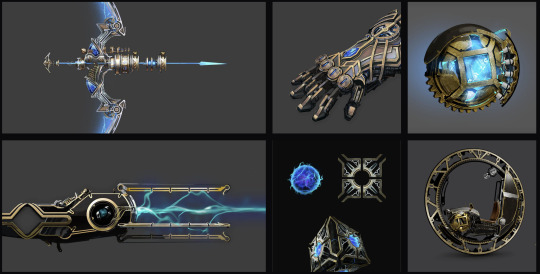

In the bottom series of pictures, three of the images are in black and white, and look more like sketches than the fully-rendered designs of the other inventions. The first of these images is just a string of merchant clan sigils, which don't give us all that much information. What I'm most interested in are the second image, which is a dome-shaped streetlight:
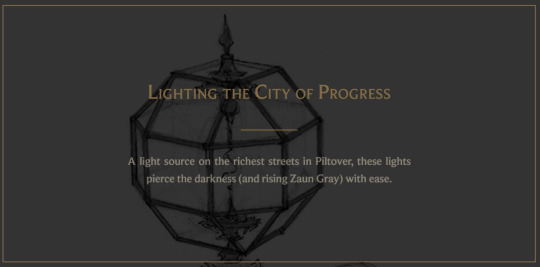
And the third image, which is a "Pneuma-Tube Conduit":
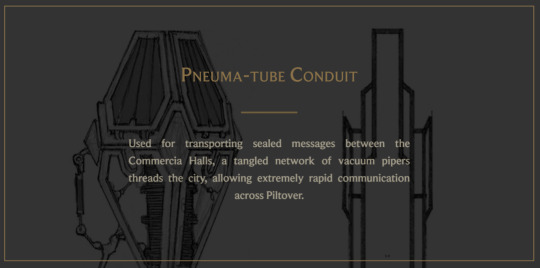
The black-and-white design of these makes them look older, as opposed to the modern designs of objects like the gauntlets, which we know are newer. That indicates that these inventions existed before Hextech. The light source looks like it has a wire running through it and a switch of sorts, which suggests that they had some form of electricity. Another possibility is that it functions using solar power, given that the Zaunites, despite being inventors in their own rights, seem to rely mostly on Chemtech for light and haven't been able to built light sources that can pierce darkness/the Grey. It would make sense if they simply don't get the sunlight down there to operate them properly.
The pneuma tube is the most notable to me, given that it seems to match the tube Grayson gives Vander in Episode 1 as a method of contacting her ("this will reach me, and only me") - again, before Hextech existed. What's interesting about that tube is that, when I went back to the scene where Vi decides to turn herself in, the tube arrives with a puff of gas and a small lime-coloured light that turns on. There's also a green-tinted lamp in the police station where they appear to be located. It looks very Chemtech-like, which I'm intrigued by; it makes me wonder if Piltover actually does use Chemtech to some extent, but in much smaller doses with extensive safety measures to keep the gases from escaping.
I also found a Weebly website, which looks very unofficial (i.e. I cannot verify any of the information on there) but has a ton of lore for various regions, including the only mention I could find of a Piltovian energy source that wasn't Hextech. The site mentions that Piltover uses liquids and gases from a nearby marsh to power the city. This seems like a viable option to me, especially given the detail of the gases coming off the tube, and the images of factories with smoke coming from the underground. So I guess, rather than being Zaun's "answer" to Hextech, Chemtech is more like the toxic and volatile version of the various controlled gases and liquids that Piltover uses as an energy source.
On the topic of other things Piltover invented, here are some additional notes from my research:
Weaponry - There are guns everywhere in Piltover, particularly for the Enforcers. Presumably one of the wealthy clans had to manufacture these.
Tools - We know that the Talis family gained wealth and notoriety for their invention of various tools, including mostly hammers and the "collapsible pocket wrench".
Lock System - Amanda Overton stated that the Kirammans became wealthy for building "the very important lock system in the channel that first allowed trade between regions". I suppose this must have been instead of the Sun Gates, if we're assuming they don't exist?
Other Systems - The Kirammans also appeared to be the ones who built the underground ventilation system for Zaun. The tube conduit is also an example of a miscellaneous system invented by someone in Piltover, as well as presumably whatever wiring system allows the streetlights to function.
Machinery/Machine Parts - It's mentioned in League lore that the Medarda clan became wealthy for their invention of the piston, which is part of an engine. It's unclear whether this is still the case in Arcane, though.
Prosthetics - In the story The Lady of Clockwork, it's said that Corin Reveck was renowned for his design of prosthetics. Arcane canon calls him a "revered academy alchemist", so it seems like his creations there had more to do with chemistry and magic, but prosthetics could have been the specialty of someone else in Piltover.
Clockwork - I've also seen Corin Reveck described as a clockwork inventor, so revolutionary clocks and time-based inventions could have also come out of Piltover.
Cameras - Caitlyn has a camera in Act 1 when she's investigating the crime scene after the Firelights raided Silco's shipment. The flash has a blue tint, so this could have been a Hextech invention, but I was interested to see that it had a green pipe running along the side; perhaps it was a Zaunite camera that she asked Jayce to modify for her.
Food/Drink - In S1E4, it's mentioned that Councillor Hoskel ships wine to Noxus. Perhaps some clans in Piltover accumulated wealth from unique food/drink products that other regions could not cultivate.
Various Gadgets - Mel's very first scene shows her choosing a gift for Hoskel from an assortment of mechanical gadgets. These could have been a smaller byproduct of Piltover's invention boom. This category also covers the items in Jayce's lab, many of which seem to be assorted gadgets like the nose hair trimmer, the spinning mobile on the ceiling and the "real Valdiani".
So, to recap, here's a summary of the integrated timeline for P&Z in Arcane:
Pre-772 AN: Westward migration led to the establishment of the sea port of Oshra Va'Zaun. Wars ravaged the Shuriman Continent, but Oshra Va'Zaun was protected through all of it, until their own innovation caused the collapse of the isthmus via Chemtech bomb.
Post-772 AN: Piltover was gradually built over the ruins, and formally established in 790 AN. Meanwhile, those still living underground were forced into labour, working in the mines and factories to provide for Piltover's inventions. Piltover became richer and richer as trade increased, while the people of Zaun had nothing themselves.
959-972 AN: Births of the leading cast members. Jayce is the oldest, and Jinx is the youngest.
983 AN: Events of Act 1. Vi, Powder, Mylo and Claggor raid the Kiramman warehouse. Hextech is invented. Vander turns himself in for the raid, Silco intercepts the arrest, and Vander, Mylo and Claggor end up dead.
990 AN: Events of Act 2. The main Arcane timeline starts here.
~~~
Part 2.1: Geography (Maps)
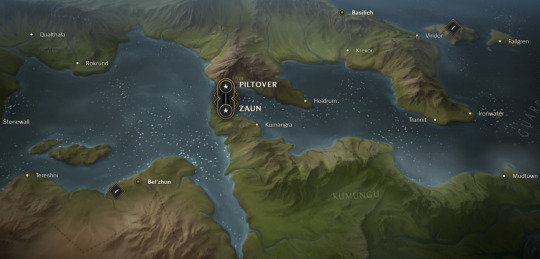
Figure 1: Piltover and Zaun in the wider landscape of Runeterra (source)
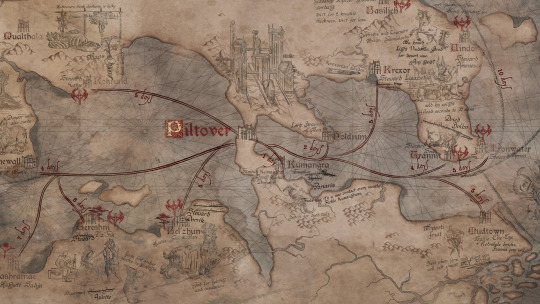
Figure 2: Piltover trade routes per the Medarda Heirloom (source)
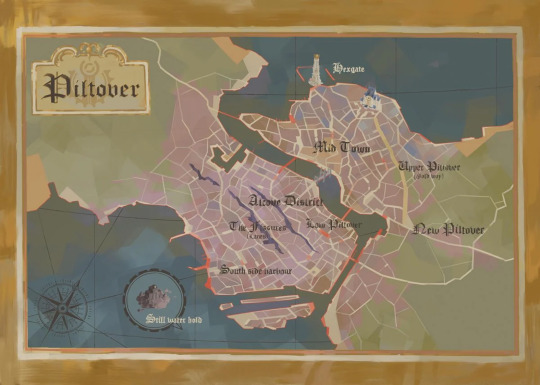
Figure 3: Piltover and Zaun map in Arcane (source)
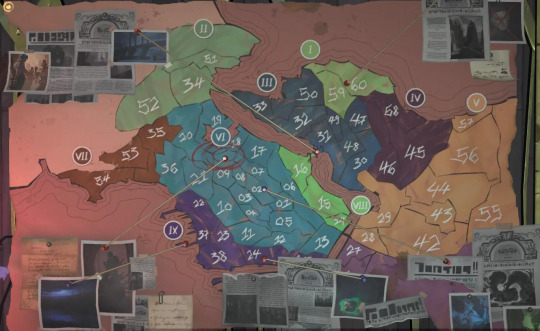
Figure 4: Map of Piltover and Zaun from Jinx Fixes Everything (source)
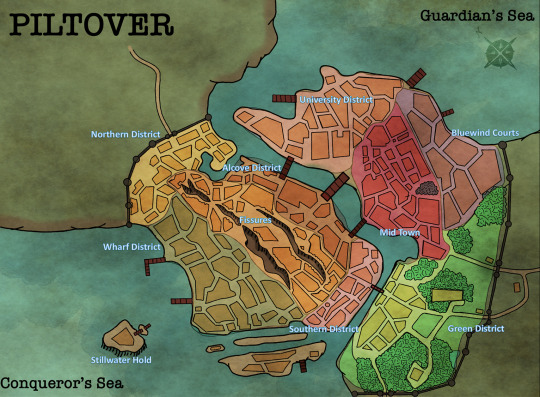
Figure 5: Map of Piltover and Zaun from World Anvil (source)*
*I'm not sure of the exact source for this map; the page I found this from is a fanmade D&D campaign but the creator has a disclaimer that they sourced the artwork externally and do not own it.
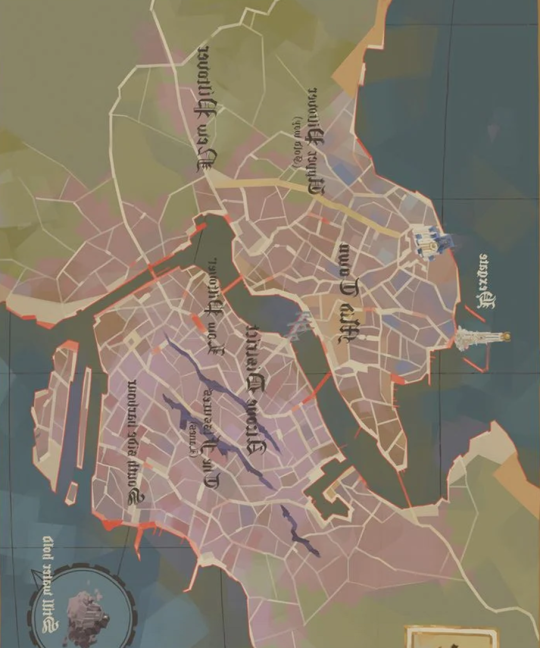
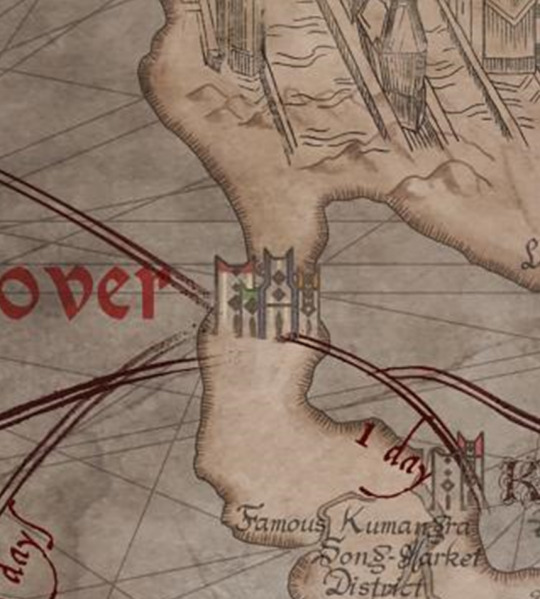
Figures 6 and 7: Maps of P&Z from Arcane and the Medarda Heirloom respectively. The Arcane map has been rotated to align the structure of the land masses in the Medarda Heirloom.
~~~
Part 2.2: Geography (League of Legends)
In League, Zaun is built quite literally underneath Piltover; there are some absolutely beautiful official artworks depicting this. In the League version of Zaun, there are three levels, as per the Wiki page:
Promenade Level: The top level of Zaun. Described as an "entertainment and commercial zone", this is where Zaun's wealthy reside, and where the line between Piltover and Zaun blurs. Some of its features include a thriving marketplace on the boundary (several regions are named specifically; the Boundary Markets and the Skylight Commercia), a pump station to move clean air from Piltover into Zaun, and the College of Techmaturgy.
Entresol Level: The level just below Promenade, this is considered the main hub of activity for Zaunites. It's one of the most populated districts between the two cities, and is also where the Zaun Grey lingers most. Some of its features include augmentation parlours for prosthetics and other bodily augmentations, a breather station where Zaunites can find reprieve from the Grey, the Chemtech Seam in the cliffs where compounds for Chemtech are sourced, markets and greenhouses, and laboratories for science and invention.
Sump Level: Zaun's deepest level where the light doesn't reach. It's chaotic and grim, with disorderly piping everywhere and discarded waste from Piltover. This is the origin of the Grey, from polluted waterways and grilles. Some of its features include a pump station for removing sewage, a prison mine where convicts are forced to mine Chemtech compounds, factories and warehouses, a surviving clock tower from Oshra Va'Zaun, densely-populated slums, the Black Lanes where merchants and thieves do business, sewers, an orphanage and an asylum.
Other Features: There's a large cliff in Zaun that makes up part of the Promenade Level, and is home to shipping docks and the Sun Gates. There are also Hexdraulic Conveyors in various locations throughout Zaun, which allow Piltovans to descend into Zaun - some available to the public, and some for private use, especially for the Chem-Barons and wealthy Piltovans.
As for Piltover, per the Wiki page, there are only two main regions - North Piltover and South Piltover:
North Piltover: Most of the clans have their mansions and "heavily guarded workshop compounds" here, in a region called Bluewind Court. The north also contains a menagerie, theatres and workshops, a promenade of cafes and bistros, and a region dedicated to banks and secure vaults for the wealthy.
South Piltover: Not much is mentioned of South Piltover, but it seems like it involves several shopping districts, more workshops and lavish residences, and the fissures where Zaun is located.
I recognised a lot of the location names on the Wiki from the map in Figure 5, so presumably the north just means everything north of the canal and the south is the region on the other side; then Zaun exists directly underneath southern Piltover, carved out of the land underneath the fissures.
~~~
Part 2.3: Geography (Arcane)
The geography in Arcane was a little confusing to make sense of. These are the changes noted on the Wiki:
The Sun Gates do not exist
The fissures are narrower
Zaun does not have three levels, instead being divided into the Lanes which each represent one of the fissures
The tallest tower in Zaun is now the Chem-Baron tower, which replaces the College of Techmaturgy
There are no Hexdraulic Descenders, instead replaced by smaller elevators
The Lanes in Zaun are home to Babette's brothel and The Last Drop
The Firelight Hideout is built in a large, abandoned sewer
The north and south parts of Piltover are connected by The Bridge of Progress
In mid-Piltover is the University of Piltover, located near the Hexgates, where most council meetings take place
Stillwater Hold is located on an island just outside the eastern part of the city
I've read a lot of other forum threads, and it seems like there's no real consensus on where exactly Zaun is located in relation to Piltover. Some people say it's still directly underneath southern Piltover, while others think the entire region across the bridge (see Figure 3) is now entirely Zaun. I get the impression that a lot of the confusion comes from Arcane visuals that make it look like Zaun is just everything on the other side of the bridge. Vander also describes the Undercity as "our side", making it seem like Zaun is that entire side of the region rather than just a part of it built underground.
Personally, I'm inclined to think Zaun is still predominantly underneath Piltover, judging by the maps in Figures 3 & 4 from Arcane canon. It seems like the Alcove District, Low Piltover and South Side Harbour are still part of south Piltover, while everything around the Fissures are part of Zaun. The scene in Season 1 Episode 1 where Vi and the kids are running away from the Enforcers also seems to support this. They run through a corridor, then slide down a sewer grate, into the underground where we can see all of Piltover's metal scraps and parts discarded as per the lore. I presumed, from this, that the first place they entered across the bridge was still part of Piltover, and then they went down the pipe to get to Zaun. Deckard confronts them before they take the elevator even further down, and we know that this confrontation happened on their "side", per Vi's conversation with Vander, so this was likely an upper part of Zaun.
Additionally, we see this wide shot as they run across the bridge:
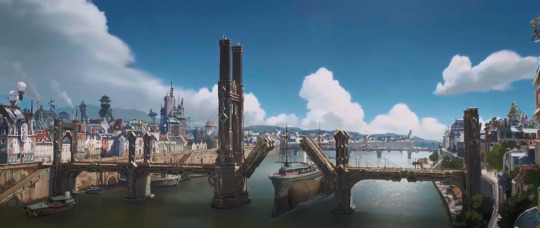
Figure 8: Wide shot of the Bridge of Progress from Season 1 Episode 1, timestamp 13:01
Figure 8 shows Zaun/South Piltover on the left side of the bridge, and North Piltover on the right side. The architecture immediately across the bridge still looks very Piltovian, while towards the back of the image, we can see large green towers and smoke, more akin to Zaunite infrastructure. This makes me think there's still something like the Promenade level at the same altitude as south Piltover, where the lines between cities are blurred, but most of the activity takes place underneath. The maps from Arcane are also specifically labelled "Piltover", which further supports the idea that the entire region is Piltover, with most of Zaun lying underneath.
~~~
Part 2.4: Geography (Integrated)
I don't think Zaun was just made up of the Lanes, as the Wiki page seems to imply. There's a line from Silco in S1E3 in which he says "not just for the Lanes, but the whole of the underground united as one". It seems like the Lanes were the region Silco and Vander had control over ("you had my respect, the Lanes' respect" - Vander, S1E3), but there were other parts to the underground too.
There's a really useful Twitter post here that proposes one theory as to how Arcane and League geography can be integrated. As previously mentioned, I like the idea that the levels still exist to some extent. The Promenade level bleeds into South Piltover, and looks to be where many of the factories and warehouses are located judging by the smoke - as well as, of course, the Chem-Baron tower where Silco gasses them all in S1E7. This is also where the fight with Deckard happened. Every theory I've seen that incorporates the levels places The Last Drop on Entresol, so I'm inclined to say that's where the Lanes are located, with The Last Drop a central feature, and quite close to the Sump. And the Sump is where the mines are, all the way down in the lowest inhabitable (using that term very loosely) part of Zaun. There are also ruins of Oshra Va'Zaun underneath this where it's completely deserted.
~~~
Part 3.0: The Creation of Modern Zaun (Preamble)
So all of this brings me back to the question at the heart of it all: where do Silco and Vander fit in? There are three big questions I am aiming to answer in this section.
Question 1: What is the timeline of Silco and Vander's past?
Question 2: What did Zaun look like before Silco and Vander took control of it?
Question 3: What was their vision for Zaun and how far did they get with it?
Before I can get into answering those questions, I want to compile everything that we already know about Silco and Vander. From Arcane canon, here is what we're given:
Vander and Silco started as miners who "had nothing" (Silco's words, S1E9), and had a shared vision for what Zaun could have been. Silco talks very distastefully about his experience in the mines, describing "air so thick it clogged your throat, stuck in your eyes".
They are said to have "built the underground", according to Sevika (or, at the very least, she says that Vander built the underground).
Zaun was governed by Piltover and their council; Silco and Vander wanted Zaun to become an independent nation in its own right.
Silco’s description in S1E3: “We shared a vision, Vander. A dream of freedom. Not just for the Lanes, but the whole of the underground united as one. The Nation of Zaun.” In S1E9, he also says "everything we ever wanted" when he's talking to the Vander statue about Jayce's offer of peace, so all signs point to them having both been set on independence for Zaun.
Sevika says that "Silco spent his whole life trying to rally the Undercity together" in S2E4.
At some point, Felicia joined their fight, and the three of them were seen at The Last Drop together around the time of its founding. Sevika and Connol also knew them in their youth. I don't believe it's ever explicitly stated whether Benzo knew them back then, but Vander mentions him by name to Silco, which suggests a mutual connection.
Felicia speaks about the vision for Zaun as theirs, not hers, so it seems like her role was not quite as prominent as theirs in the actual conception and construction of Zaun.
Felicia encourages Silco and Vander to "figure this Zaun thing out", even if they have to "carve it out of the bedrock, covered in blisters". Much like Sevika using the word "built", this seems to imply a very literal kind of construction.
When Vi, Powder and co raid the Kirammans' warehouse, Vi mentions that it's exactly the kind of job Vander would've done when he was their age. We know that Vi was 16 at the time, and Mylo and Claggor were also both older than Powder, so presumably she means 15-16.
In S1E2, Vander tells Vi that when he was younger, he "was angry" about the treatment of Zaun by Piltover, and led the bridge riot that killed Felicia and Connol.
Using this post and the Arcane artbook as a guide, I also pulled information out of comments from the creators, which I'm regarding as canon-adjacent:
The Lanes is the black market area of the Undercity, created through Vander and Silco's smuggling operation that gave them the chance to make money outside of working as miners for topsiders.
Silco "grew up working in the mines", which is where Vander, Silco and Felicia met. It's also mentioned that this is why he was the only one who could tolerate the gas in S1E7, but he specifically says that the Chem-Barons used to work in the mines as well (“The mines they had us in” / “I pulled you all up from the depths”), so that seems inconsistent. I'm inclined to believe that it's a combination of him growing up in the mines and continuing to live on the Entresol level (in The Last Drop), while the others lived on the Promenade level.
Silco and Vander led a movement towards independence. Both were unhappy with the "oppressive feeling" of being "under the thumb of Piltover".
In the artbook, it's said that Silco hated the way he was treated by Piltover and wanted to prove that he was more than what the world had made him out to be. He and Vander "tried to build this world together", with the main goal of independence and pride for Zaun. Ultimately, there were limits to what Vander was willing to lose, while Silco always wanted to keep fighting no matter the cost.
There's an image of young Benzo with Silco, Vander and Felicia in the artbook, confirming the implication that he knew them at that time.
The bridge riot was incited after Benzo got arrested, and Silco was the one really pushing for the uprising; hence he was the one who threw the first Molotov cocktail. This was when Vander decided that violence was not the way to achieve peace.
Amanda Overton frequently refers to that riot as the "Day of Ash". I could only find one source on this, a Fandom Wiki page with no additional references cited. According to this page, the Day of Ash took place on December 1st 979 AN, and involved a protest march on the Bridge of Progress in which over 100 unarmed Zaunites were shot and 84 died on the spot. This seems inconsistent with what we see in canon (the "unarmed" part specifically; Silco throwing the Molotov, Vander beating up Enforcers with his mining gloves), but I'm listing it here anyway for full disclosure.
The drowning incident happened after the riot, apparently after Vander had already taken the kids (so I guess he came back for Silco??? Or it happened a few days after?).
Something else worth noting is that in the Season 2 flashback, Felicia says that "tonight", their dream of turning the underground into a community became a reality. This obviously marks a very significant date for them, and they toast to the occasion. My assumption was that this was meant to show us the opening of The Last Drop, and that's what I ran with for much of my analysis throughout this section; however, I don't think it's ever actually specified which milestone they're celebrating, so this detail is ultimately up to interpretation.
~~~
Part 3.1: The Creation of Modern Zaun (Timeline)
All of the wiki pages I've looked at place Silco at 37-39 in Act 1, and 43-46 in Act 2; and for Vander, 43 in Act 1 and 50 in Act 2 (in the AU/as Warwick). As far as birth years go, this would translate to 944-946 AN for Silco, and 940 AN for Vander.
At the time of The Last Drop's opening, Felicia is pregnant with Vi. That would place this scene in either 966 or 967 AN. I struggled to find an official reference for Arcane character birthdays, but Vi's birthday is very consistently celebrated on December 19th across the fandom, which puts us in early 967. That makes Silco and Vander 21-23 and 27 respectively. Based on what we see of Silco in that scene, I'm inclined to place him at the upper end of that range, or even a year or two older. So more like 39-41 in Act 1 and 46-48 in Act 2.
The Day of Ash is an interesting conundrum. 979 AN, as per the wiki article I found, would make Vi and Powder 12 and 7 respectively. I'm not sure how reliable the source is, and my personal estimate would have been 977-978 AN, factoring in the kids' ages and the time it would take for Silco to rebuild his life from scratch.
Combining all of this information, we get the following timeline:
940 AN: Vander is born
942-944 AN: Silco is born
966-967 AN: The Last Drop is opened
977-979 AN: The Day of Ash
For the next few sections, I'd like to have precise years to focus on, so I'm going to run with these dates:
940 AN: Vander is born. He is 43 / 50.
943 AN: Silco is born. He is 40 / 47.
967 AN: The Last Drop is opened. This marks the birth of modern Zaun.
978 AN: The Day of Ash. Silco is betrayed, and Vander swears off violence.
~~~
Part 3.2: The Creation of Modern Zaun (Early Life of S&V)
Content warning for discussions of slavery/slave labour in this section; I'll mark the paragraph that includes this with ~!!~ at the start just in case anyone wants to skip it.
It's pretty solid canon that Vander and Silco started as miners, and built up their world of Zaun from there. The mining tunnels run all along the fissures, as per this map from the Jinx Fixes Everything minigame:
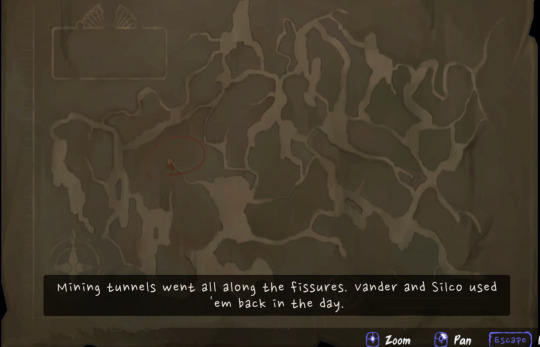
Figure 9: Map of mining tunnels from Jinx Fixes Everything
I get the impression, based on the prevalence of the tunnels & Silco's dialogue to the Chem-Barons ("We had nothing" / "Have you forgotten where we came from? The mines they had us in?") that the underground, at the time, was mostly just mines.
~!!~ I'm particularly interested in how this fits in with the original League geography of the Sump, given that's where the mines are located. In League, the Sump included a prison mine for "Chemtech compounds", factories, warehouses, and slums where the workers lived. There's one particular factory mentioned which involved "slave labour camps" and "tightly controlled torture chambers". This is a very dark but plausible look into one possibility for the Undercity's past. Since Silco and Vander were said to have grown up in the mines, I assume it's most likely that they were the children of prisoners, rather than prisoners themselves - although it isn't outside the realm of possibility, since Powder's visibly young age did not stop the Enforcers from going after her at the beginning of the show. Alternatively (if we want to assume the slave labour aspect did not exist/was very far in the past) we could just assume Vander and Silco were children of people who worked in the mines, and were essentially born into it.
Regardless, I don't think they had many other options outside of mining, so we can assume that this was much the same for most people living in the Undercity. Something I'm curious about is, with the interpretation that there was still some semblance of a level system in modern Zaun, when and how Entresol and Promenade came about.
My personal assumption for Promenade is that the level existed as a sort of gateway between south Piltover and the underground. The elevator from S1E1 is on this level, and it looks to be in an abandoned house, judging by the stairs, furniture and paintings on the walls. The decor is quite fancy and the people in the paintings are dressed similarly to the Kirammans in their family portraits, which makes me think this was the repurposed home of a wealthy topsider. One possibility is that Promenade held the residences of Piltovan elites who worked close to Zaun (e.g. owned factories, oversaw mining operations). I think it's unlikely that Promenade had anything to do with Silco and Vander's operations, since it's much closer to the surface than where they reside, but their revolution could have been the force that drove many of the topsiders out.
Entresol is where the Lanes and The Last Drop are located, so I'm inclined to assume this was the part that Silco and Vander built. This is also corroborated by the various references to the Lanes in S1E3, which I elaborated on in Part 2.4, that makes it sound like this was the part that they had the most involvement with. This was where both of them ended up living, and Vander says that Silco "had the Lanes' respect", suggesting that this was where they started out, too.
The way Sevika and Felicia both talk about Silco and Vander's work makes it sound like they built the Lanes in a very literal sense. This leaves us with two main questions; 1) What was there before?, and 2) How much of it was built by them?. Unfortunately for us, I don't think there's actually enough in canon to answer either of those questions with any real certainty. The best I can do is suggest possibilities. We do know that there were other parts to the underground outside of the Lanes, so one possibility is that there was already a community inhabiting Entresol that they took over as their own - perhaps a small rebel group, or colonies of Zaunite labourers who lived on that level. These are all the other options I came up with:
There were semi-intact ruins still lying around Entresol that they built out of.
There was a large, empty space in the place that would later become the Lanes. They built on top of this and filled out the entire region.
They literally built the Entresol level themselves. The mining tunnels had been dug out of nothing, and all that was lying on top of them was rock; they quite literally "carve[d] it out of the bedrock", as Felicia's phrasing would imply.
So in summary, I'm imagining that the Sump was the main region of the Undercity at the time, comprising a network of mines where the Grey originated, sewers for wastage from up above, and potentially factories or warehouses as well. Another question is what exactly was being mined here, and again, we can turn to League lore for possible ideas. The prison mines mentioned on the Zaun wiki page were for "Chemtech compounds". Amanda Overton described Silco and Vander as "miners working for topsiders", which makes me wonder - if they were mining for Chemtech compounds - what exactly the topsiders in question wanted to do with those compounds. This brings me back to my long-winded Chemtech musings from Part 1.3. I can think of three primary explanations for this:
The compounds in question could be used for a variety of inventions, not just Chemtech. Perhaps there were elements involved that had to be chemically separated; one of which was safer and used to power Piltover's inventions, while the other was highly toxic and was originally discarded as waste, but later became the basis for Chemtech.
Chemtech was mined and used in smaller doses/quantities in Piltovian inventions, while the people of the Undercity began to use it in larger quantities, harnessing the toxic properties that released the Grey as a byproduct.
Chemtech compounds were one of many things mined, and were used for inventions that were limited to the underground, like mechanical mining and factory tools (drills, bombs, transport, etc.)
Alternatively, if we ignore the mention of Chemtech, we could assume that the underground was rich in natural minerals and resources that Piltovans needed for their inventions. We could also assume they were mining for the other gases and/or liquids that Piltovans used as an energy source (it's mentioned that these came from a "nearby marsh", but I couldn't find an actual canon source for that, so I think it's fine to take some liberties with it). I suspect that there are many other possible explanations, with the foundational principle being that they were mining for materials which the topsiders would then use to boost their own wealth, one way or another.
~~~
Part 3.3: The Creation of Modern Zaun (Golden Age of S&V)
In S1E5, we see an old hideout of Silco and Vander's, with plans for the Nation of Zaun strewn all over the desk and plastered on the walls. I've compiled a list of everything we see in that hideout and where it's all located:
CEILING/TOP
Pipework
Low wooden beams
Lantern box hanging from the ceiling
LEFT OF THE ENTRANCE
Boxes/crates
Barrels
Mining gloves
Shovel
Something coiled and hanging on the left wall - perhaps a rope? Or a hose?
RIGHT OF THE ENTRANCE
Small wooden table
Vanity next to the coat rack
Another shovel
Time-worn plans covering the right wall (maps, tables, lots of illegible writing)
BACK OF THE ROOM
Left corner, storage unit/bookshelf (books, boxes, small lopsided paper bag, cylindrical flask or thick drink bottle?)
Left of centre, jackets and hats
Centre, flag with green, red and gold detailing, NoZ logo in gold
Right corner, coat rack and a ledge with hangers and a kettle
CENTRE OF THE ROOM
Desk (more books, flask, glass, tobacco pipe, letter)
Another crate
Knocked-over stool
Tall chair (for the vanity?)
TRIVIA
Walls are all boarded up with wooden planks and metal reinforcements
Vander’s number: 135 714 (from the canon scene)
Silco’s number: 132 219 (loosely interpreted from the very grainy image in the artbook)
I think it's safe to say that they started devising their vision of Zaun in the mines, with comprehensive plans for the nation that include maps and diagrams, a flag with a logo, and many long pages of writing. I'm guessing they were living here for a while, judging by the flask, the kettle, the paper bag that looks like the kind used to carry food, and the clothes hung up on the wall. The furniture is an interesting detail; I'm struggling to imagine that they got away with dragging all of that furniture down to the mines, which makes me wonder if it was there before. Perhaps it used to be someone's office down there? Or some kind of bunker/storm shelter? I have no clear answer for this so I guess it's entirely up to the imagination.
Then at some point, they got out of the mines and began a smuggling operation to make money. I assume this is the era Vi was talking about when she said the break-in was "the kind of job Vander would've pulled when he was [their] age". I'm not sure exactly how reliable this statement is, or whether it even really tells us anything; Vander could've snuck away from the mines to steal from topside when he was a teenager, before he had even developed the goal of an independent nation, or Vi could've heard rumours about Vander's past that weren't entirely accurate. Still, it's the best we have to go on, and if we assume this references Vander and Silco's smuggling operation, it would imply that they started relatively young. In my opinion, 16-year-old Vi saying "our age" could imply anywhere from about 15-18 realistically, and that gives us a maximum of about a decade between the start of their smuggling ventures and The Last Drop opening. We also have to factor in Silco being 2-3 years younger, which means I'm more inclined to assume Vander was an older teen, if not already in his 20s (unless we're meant to assume they were just extremely young when they started all this, but I think that's unlikely, given they already look like adults while still working in the mines). For the sake of the timeline, we'll say they started their smuggling operation somewhere between the late 950s and early 960s AN.
We also don't know for sure when the Lanes were actually built; whether they started with The Last Drop and built everything around it, or built the Lanes and opened The Last Drop as a finishing touch of sorts. Felicia's lines in the flashback - "You two are going to figure this Zaun thing out. I don't care if you have to carve it out of the bedrock covered in blisters." - definitely make it sound like The Last Drop was built first, and everything else followed. Amanda Overton also specified that the smuggling operation helped Vander and Silco make money, so it seems like they were selling their stolen goods (to topsiders?) and running a back-alley black market operation until they had enough to actually start building.
There were about 10-11 years between the opening of The Last Drop and the estrangement of Silco from his allies, which they spent building the Lanes. I was initially thinking this sounded insane, but from this Reddit thread, I gathered that it's actually a fairly reasonable timeline - especially if we assume that they had others helping them with the physical construction, which I'm certain they would've. One of the commenters in the thread brought up the city of Brasilia, which was a planned city built over the span of about 3.5 years. It has a total federal district area of 5,802km^2 built by about 60,000 people (not sure exactly how much of that area was actually built up; the Demographia World Urban Areas Report 2023 counts a total urban area of 963km^2, similar to the size of Buffalo NY).
There's another post I found by a Redditor who calculated the area and population of Piltover and Zaun using the height of streetlamps as a reference. These totals came out to 5.30km^2 (~100,000 population) and 4.12km^2 (~400,000 population) for Zaun. This was calculated under the assumption that Zaun and Piltover each covered one region on either side of the bridge, so the sizes might differ under the model with Zaun being mostly underneath. However, in this case, the Entresol level alone would be even smaller than 4.12km^2, so the task sounds overall very manageable. Worth noting that I think it's unlikely that Zaun was a precisely planned city like Brasilia was, and more likely that they built up the city around themselves, in response to the growing population and demands for facilities. Although we do see very thorough-looking diagrams on the walls of Vander and Silco's hideout, so I suppose you could reasonably assume any degree of planning.
In canon, we do see some glimpses into the post-Last Drop era through the sequence of Warwick/Vander's memories in S1E6. Here are all the memories we see, in order:
Vander and Silco in the mines
Silco sitting at a bar with a book open in his hands
The flashback from S2E5 with Felicia, Silco and Vander toasting in the bar
Young Vander and Benzo leaning over a counter; both look to be around the same age as they were in Act 1, maybe slightly younger
Felicia pregnant with Powder, and a man (presumably Connol) holding child Vi
Powder, Vi, Mylo and Claggor all standing in a group with their backs turned
Vi sparring with Vander, starting around the age she was in Act 1 and then morphing into her younger child self
Felicia and Connol come home with their mining hats and gloves, and Vi and Powder get excited to see them
Vi tries on the mining glove Felicia gives her
Felicia and Powder cook together
Felicia cuts Vi's hair
Felicia, Powder and Vi chase each other around a post
Felicia measures Vi's height
These being Vander's memories, it seems like the kids had a much more resonant impact on him at the time than Silco or the fight for independence did. This explains a lot with regards to the difference in ideologies that eventually divided Vander and Silco. We also see that Felicia and Connol were still working in the mines when the kids were young, implying that Silco and Vander did not shut down mining operations (perhaps they cleaned it up so the work was less dangerous?). The logo for the Nation of Zaun that we see on the flag & on Silco's notebook doesn't come up ever again, and seems to be absent from the modern timeline.
I'm guessing the focus during this period was on the physical construction of the Lanes, and accumulating more and more capital to distribute among the people of the underground. It definitely seems like they were intending to go to war for their independence, judging by Vander's assumption in S1E3 that Silco wanted to use Shimmer to start a war - as well as Vander telling Vi that he "was angry" when he was younger and wanted to fight for change (S1E2). The flag/logo in their hideout was presumably something they planned to fly once they had achieved an independent Nation of Zaun.
They never did end up engaging in a full-on war though, based on various context clues and dialogue exchanges implying that a) Vander and Silco's revolution was never successful, and b) war between Piltover and Zaun is only hypothetical, rather than something that has happened once before. Vander also indicates that the Day of Ash was a one-off incident ("we crossed that bridge once before" in S1E2), which is consistent with how peaceful his early memories are. I presume they wanted to focus on establishing Zaun as a thriving community first before escalating the issue with Piltover; they couldn't exactly fight for independence if there was no nation to fight for in the first place. They most likely didn't have the numbers to form an actual army either, especially not with the Lanes alone.
Eventually, Vander and Silco incited the bridge riot as what was meant to be the start of a bigger revolution, "thinking things could change". The riot was a massive failure for Zaun, and most of the fighters ended up dead. Vander decided that he had too much to lose and attempted to drown Silco to end the cycle of violence. I tend to assume this happened before Vander picked up the kids, but if you want to stay as loyal as possible to the creators' comments, I think this is a very plausible theory that explains the weird timeline and visual continuity errors.
~~~
Part 3.4: The Creation of Modern Zaun (Aftermath of S&V)
Bonus section to discuss my thoughts on what exactly happened to Silco after the Day of Ash; most of this is conjecture rather than fact.
It's pretty obvious what Vander got up to after the drowning attempt. He made a deal with Grayson to keep Zaunites off of Piltover's streets in return for peace. Much of the infrastructure in The Lanes was built during Vander and Silco's era, but I imagine construction continued into this era as well. However, any progress towards independence stagnated under Vander's leadership.
As for Silco, it seems most likely that he met up with Singed pretty soon after the betrayal. There seems to be a distinct lack of trust between them - Singed hasn't told Silco what his true motivations are, per him vaguely telling Silco "I, too, once had a daughter" (S1E8), and Silco tells Jinx that "you're the only one I can trust with this" when she suggests that he give the Hex crystal to Singed instead (S1E5). Thus, I'm inclined to believe it's a purely practical partnership, unlike Silco's relationship with Vander which was much more personal.
Silco's intention with Shimmer, as he tells Vander, was to mass-produce it at such a scale that it would scare Piltover out of entering the Lanes (many of the wiki pages say he wanted to start a war with Shimmer-enhanced soldiers, but he outright tells Vander that this is not the case). It could be that he wanted a bargaining chip too, given that "discontinue the production of Shimmer" was one of Jayce's conditions for independence in S1E9. So, Silco and Singed joined forces at some point to mass-produce Shimmer, Silco used a variant in the meantime to keep his eye infection at bay, and that brings us to the canon timeline.
I want to look a little bit into Singed and his past, as I'm very curious to know where Silco's vision fits in with Singed's motivations. We don't know exactly how much of Dr. Reveck/Orianna's story translates into Arcane, but we do know the following:
Singed was Dr. Reveck, a "revered academy alchemist" in Piltover. His work was "unparalleled", but he was dismissed from the academy with "no mention of his crime" (from Caitlyn; S2E5).
Everything he's done since his dismissal was to cure his daughter. This included the creation of Shimmer, which he did using Rio (the giant purple creature in the cave) as a vessel through which to sustain the regenerative mutation he wanted to harness. When questioned by Ambessa, he says that he's trying to cure "death".
He runs his operations out of the cave in Zaun where Rio is kept. Viktor worked with him briefly as a child, but became horrified by the sight of Rio connected to a series of wires and clearly in pain, so he left. Later, he is seen working out of several locations that all look slightly different (the place where Warwick is created, and Silco's first office under the river), so either the cave is massive with many rooms, or he has several different HQs for his experiments.
Singed uses Chemtech and Shimmer for all his experiments, often a combination of the two. It seems like Chemtech has the potential to sustain life, and Shimmer has the potential to enhance it.
In comparison, these are the main details of Orianna's origin story in League of Legends:
Corin Reveck was famous for making artificial limbs with intricate brass designs.
His daughter, Orianna, was his apprentice. She was adventurous and inquisitive, and wanted to explore the world outside of Piltover, but Dr. Reveck told her it was too dangerous.
An explosion in Zaun ruptured a chemical line and released clouds of poisonous gas. Orianna wanted to help the victims, but Dr. Reveck wouldn’t let her.
Orianna snuck away at night and helped fix the damage, repairing respirators and installing esophilters (described on the wiki as “a Chemtech augmentation that allows people to breathe noxious fumes safely”). She offered her own mask to a child who was struggling to breathe.
After returning to Piltover, Orianna became terminally ill, lungs ravaged by the toxic fumes. Dr. Reveck built her a new set of lungs, and as the poison spread throughout her body, he continued to build new implants and prosthetics for her until most of her body was mechanical.
The process cost Dr. Reveck his entire fortune, which forced them to relocate to Zaun.
Eventually Dr. Reveck fell ill, and she gave up her last remaining human organ for him - her heart.
There are obvious changes that would have to be made to this story to fit with Arcane lore. For example, Singed was already living in Zaun by the time he met up with Viktor, well before Orianna was revived. It also doesn't seem like he built her "piece by piece" as stated in the original story, instead keeping her alive and unconscious until he was certain he could save her. However, I think a lot of these details can be integrated with Arcane lore, and I have some ideas about exactly where it fits in.
As with all things, I want to figure out a timeline first before anything else. This is what we know so far:
Late 950s-960s AN: Silco and Vander start their smuggling operation with the goal of establishing the Lanes
961 AN: Viktor is born
967 AN: The Last Drop is opened
978 AN: Silco is betrayed by Vander
983 AN: Silco and Singed are working together by this point
I found no information on how old Viktor was when he met Singed, so I'm going to estimate around 12-13 judging by his appearance and voice. This would mean they met around 973-974 AN, which matches up with the timeline, given that Zaun looks quite built-up where we see other children playing (although I'm pretty sure this takes place on the Promenade level? Since it seems to be in direct sunlight). It seems like Singed is a fair way into his venture when Viktor runs into him; he's managed to cultivate the mutation he is looking for, and he has a laboratory of sorts that he operates inside the cave, with a vast array of potions, many different vats and test tubes with mutilated animals inside, and a network of pipes and wires that power his equipment. From this, I presume he's been at it for at least a few years.
With this timeline, Orianna would have fallen ill somewhere in the late 960s, right at the height of Vander and Silco's golden age when they were still building the Lanes. An explosion that ruptured a chemical line is an extremely plausible event to happen during this era, for any number of reasons; a riot in the underground, Enforcers trying to halt the construction of Zaun, explosions used to clear rocks so they had a clear path to build, etc etc. It could've been any number of things. Orianna went down there, against her father's orders, and her lungs were ravaged by the gas. Singed started to focus his research on keeping Orianna's condition stable and devising a cure by testing on animals. His unethical activities were discovered, and he was kicked out of the academy in the early 970s for his experiments. He permanently relocated to Zaun.
Sometime after Silco was betrayed, he and Singed met. I am quite confident that Silco was the one to approach Singed, and my primary justification for this comes from Singed's conversation with Viktor in S1E7. Viktor tries to pretend that he wants to use Shimmer on plants, and Singed expresses that he knows what Viktor is really there for, by saying "I know the look of a doomed man". I am convinced that he is talking about Silco here. From what we see of Singed's past before meeting Silco, he had only experimented on animals, and the only human involved before Viktor was his daughter. None of that would justify him "know[ing] the look of a doomed man". I don't think he's talking about himself either, since his injuries don't appear to be fatal and we never see him using himself as a test subject.
So I think Silco somehow found out about his operations and came to him seeking help after the betrayal. Silco had no power without Vander - all their friends/allies that we know of were either dead (Felicia and Connol) or took Vander's side (Benzo and Sevika) - and after being exposed to the toxins in the Pilt, he definitely would have been at risk for a much worse infection if left untreated. He was already taking his injections when we first see him in canon, and it actually looks like Singed might have even performed surgery of some kind on Silco, given that he has both eyelids in the actual drowning scene but one of them is missing later on.
This also helps explain what Singed was getting out of the deal, since Silco couldn't offer him anything tangible at the time; he essentially acted as Singed's first human test subject for a cure. We don't know if Silco's early injections involved Shimmer though, or if he was using some other temporary cure (Chemtech?) that Singed came up with for him before Shimmer had been perfected. Singed mentions to Viktor that he has several different variants of Shimmer, and he was already working on it for at least a little while before Silco came to him, so I'm assuming it was probably one of these variants. If that's the case, I'd guess that Silco is using a stronger dosage after the timeskip, since he responds to it differently (in S1E1 he injects it very calmly with no visible reaction at all, while later on in the series, his body seizes up and he looks to be in pain).
I'm interested in what comes after that, too. I could absolutely understand Singed agreeing to help Silco out after the betrayal, since Silco is in a similar position to Viktor at that point, and a very valuable tool in Singed's research. What I'm curious about is why Singed then agrees to mass-produce Shimmer and "flood the lanes" with it, as it's often described. These are the two explanations I came up with:
Singed wanted to explore the effects of Shimmer on the "average person", so to speak. Flooding the Lanes with Shimmer means putting it in the hands of anyone and everyone, which means ample test subjects for Singed to observe and learn from. The main issue I can think of with this theory is that Singed does all of his research from inside his lab, and one of the key things he notes about himself is that he's a loner, so it doesn't seem like he was going out there and doing field research. There could have been ways for him to learn from afar, though.
Silco offered to make Singed rich. Silco knew Shimmer could turn the tides back in his favour, and he could have tempted Singed to join him with the promise of everything they could eventually have. Early in Season 1, they share an office space underwater, and they have many giant factories with regular shipments in and out of Piltover after the timeskip. We can only assume that both of them became wealthy from this, with Singed making enough money to continue his research, and Silco making enough to build the version of the underground that he always envisioned.
And finally, I want to jump back to the aforementioned discussions about Chemtech, because something is still bugging me about it. If Chemtech existed before Hextech, and it's supposed to be this brilliant but toxic formula at the heart of Zaun's inventions, why didn't they ever weaponise it against Piltover? We know that Jinx uses Chemtech for her bombs, and Renni is seen using a chainsaw powered by Chemtech - and we also know that Silco and Vander both wanted to fight Piltover. So if Chemtech is a power source exclusive to Zaun, why didn't they mass-produce Chemtech weapons or release toxic gases into the streets of Piltover as part of their fight for independence? And after the timeskip, when Silco is working on his own, why did he focus on the production of Shimmer when Chemtech already existed?
By the time we catch up with everyone in canon in S1E1, Chemtech is very widespread. It looks like the Undercity is essentially built on it, with green lights everywhere and massive structures powered entirely by chemicals. I think it's reasonable to assume that Vander and Silco were the ones who facilitated the widespread use of Chemtech. This would fill in a lot of the gaps with regards to the precise timeline of Chemtech usage; it could have been something they once used sparingly, for things like mining equipment and light sources, but when Silco and Vander built the Undercity, it became a staple of Zaunite infrastructure. Since there was a long period over which they were smuggling goods out of Piltover and preparing to start building their nation, they could have also used that time to start developing Chemtech. I'm guessing they would've recruited someone to do this for them, since neither Vander nor Silco seem to have a knack for invention.
This leaves me with three theories with regards to the potential for Chemtech to become a weapon:
Theory 1 - They did try to use it against Piltover, but their attempts were always unsuccessful (e.g. the Day of Ash riot).
This one is pretty self-explanatory. They tried to use Chemtech weapons against Piltover, but the Enforcers were just too powerful. There are two main issues with this theory; the first being that we don't know how exactly the Enforcers would have overpowered them without Hextech, and the second being that, when we see Silco and Vander on the bridge during that riot, there's no sign of Chemtech's trademark green. Silco has a very standard-looking Molotov cocktail that produces orange flames, and Vander uses his mining gloves to beat up the Enforcers using brute force. I suppose the Molotov could have been filled with chemicals, so it's still an option.
Theory 2 - Chemtech isn't powerful enough on its own.
I believe this is the most plausible theory of the three. Chemtech is an energy source, good for powering things like light sources and machinery, but in itself, we don't actually see any evidence to suggest that it's useful on a larger scale. Powder's bombs don't work when she's younger, despite being powered by Chemtech - and even then, Chemtech is never the main feature anyway, with her bombs either being smoke-powered or filled with nails. In S1E4, Councilor Hoskel describes Zaun's "ingenuity over the years", with specific mentions of "Shimmer" and "body replacements"; I would assume, if Zaun really was capable of making deadly weapons with Chemtech, he would have mentioned that as well. Chemtech does appear to be the sole power source behind Renni's chainsaw, but mass-producing chainsaws as a war weapon is not the most practical nor smart strategy. Chemtech just isn't effective enough to make weapons that can be used to fight Piltover with, or on a large enough scale to put them in the hands of average Zaunites.
A major point in favour of this theory is the fact that no one in the Undercity seems to have guns except Jinx, which I find really interesting. During the bridge riot, all of the Enforcers are armed with guns, while Vander fights with his fists, and Silco fights with the aforementioned Molotov cocktail. Later, we see that Sevika and Vi also fight with their fists, and the Firelights use hoverboards and spears. Vander has a dagger which Silco later uses as his own melee weapon of choice. So why does no one in Zaun have guns? Surely Jinx can't be the only person who's ever thought to make her own? The answer has to be that they don't have access to them; either the money to buy them or the materials to make them. The Enforcers are always armed with them, and families like the Kirammans are known to hunt recreationally, which seems to demonstrate that guns are a mark of wealth and status. Jinx is only able to make hers once she's living with Silco, who could easily source the supplies for her.
Theory 3 - They did manage to successfully weaponise Chemtech against Piltover, but Piltover was able to harness the chemicals for themselves before Zaun could take advantage of it.
We know in canon that Silco's goal was to use Shimmer as something powerful enough to scare Piltover off their streets. I think it could be interesting if this was initially the plan for Chemtech, but the council caught wind of this dangerous invention, and commissioned the academy to work on a solution - just like Silco does with Jinx when Hextech becomes an issue. Piltover created Chemtech weapons of their own, so that Zaun would no longer have a technological advantage.
This is where Singed comes in. I think it could be interesting if Singed was the alchemist recruited to work on Chemtech; perhaps even Heimerdinger too, given that Singed mentions them having worked together. Singed managed to extract the chemicals used for Chemtech and create defensive measures against it for Piltover, thus explaining why he had such a good handle on it when he transferred his operations to Zaun. Either he managed to safely extract it, and it was subsequently used for smaller inventions in Piltover (thus explaining the green lamp and the pneuma tube gas in Grayson's office), or he made weapons that were just as toxic and dangerous as those in Zaun, which had to be locked away in case of absolute emergency (this would make sense if we assume Heimerdinger had a part in it; there's no way he would let them use it freely). This theory also explains why Singed would be especially cautious about letting Orianna visit the underground, if he was working with Chemtech himself at the time and knew how dangerous it could be.
Here's my proposal for a rough timeline, using this theory:
Late 950s-960s AN: Silco and Vander start their smuggling operation with the goal of establishing the Lanes.
Early 960s AN: Chemical compounds are smuggled out of the mines, and a group of rebels start using it to develop new inventions, per Silco and Vander's plan.
967 AN: The Last Drop is opened; Vander and Silco start actually building the Lanes. Piltover catches wind of the construction and tries to send Enforcers down there to stop them, but they use newly-forged Chemtech weapons to keep them out. Enforcers are ordered by the council to stay out of the underground due to the danger. Singed (and possibly Heimerdinger) starts working with the compounds mined for Chemtech to develop stronger defensive measures.
Late 960s AN: During construction of the Lanes, something goes wrong that results in the release of toxic gases from Chemtech (a "ruptured chemical line", according to Orianna's League lore story). Singed is the first in Piltover to learn about it, and Orianna overhears. He warns her not to go down there; she does not listen. She goes to help the victims, and falls gravely ill. Singed continues his Chemtech research as authorised, but starts a side project using the chemicals to develop a cure, with a giant vat of liquid to keep her alive in the meantime.
Early 970s AN: Singed's unethical experiments are discovered, and he is booted out of the academy and stripped of his status. He permanently relocates to Zaun.
978 AN: The Day of Ash; Vander and Silco lead an army across the bridge, Enforcers fight back, disaster strikes. It's the first fight for which Piltover brings out the locked-away Chemtech weapons, which is what makes it so explosive (we see Enforcers' guns explode on impact in S1E1, which they don't seem to do any other time).
978 AN (cont'd): Silco finds out about Singed's research somehow and they meet up. Silco knows that Chemtech is no longer an advantage for the Undercity, so he seeks a new solution. Meanwhile, Vander makes his deal with Grayson, and Chemtech weapons on both sides are destroyed.
983 AN: Singed tests his newest Shimmer variant on a rat. He determines that it's now adequate for a human to drink.
This theory does have a few minor holes - Hoskel's line in S1E4 again being one of them, as well as the fact that Silco doesn't consider the possibility of weaponising Hextech until after Jinx steals the crystal - but I find it to be the most intriguing, and could be a compelling way of tying all these stories together.
~~~
Part 4: Wrap-Up
PHEW. We've finally reached the Sump. If you read this entire post, congrats on making it all the way down here! This was over 12k words total so certainly a behemoth to get through; thank you so much for sticking with me <3
I wanted to include one final summary of the timeline, colour-coded to indicate where all this information comes from. I’ve used blue to indicate origins in League of Legends lore, green to indicate Arcane lore (according to the wiki), and red to indicate that I extrapolated the dates myself. In case anyone has trouble distinguishing red and green, I’ve also included an asterisk (*) next to all the reds.
6000-5000 BN: Westward Migration. Humans began to migrate towards the Shuriman Continent. One of the new cities founded was a sea port called Oshra Va’Zaun.
2000-3 BN: Various Wars. Several wars happened during this time; Janna protected Oshra Va’Zaun from every conflict.
676 AN: Heimerdinger is born. He is 307 (Act 1) / 314 (Act 2).
772 AN: The Collapse. The people of Oshra Va’Zaun attempted to crack open an area of the land using Chemtech bombs. The bombs triggered a series of earthquakes that destroyed the isthmus.
790 AN: Piltover is Established. The ruins of Oshra Va’Zaun underwent extensive reconstruction, and the new city of Piltover was built over the Pilt River.
940 AN: Vander is born. He is 43 / 50.
*943 AN: Silco is born. He is 40 / 47.
*Late 950s-Early 960s AN: Smuggling begins. Vander and Silco start their smuggling operation.
959 AN: Jayce is born. He is 24 / 31.
961 AN: Viktor is born. He is 22 / 29.
966 AN: Caitlyn is born. She is 17 / 24.
966-67 AN: Felicia-Vander-Silco scene. A milestone of Zaun's development is celebrated in The Last Drop.
967 AN: Vi is born. She is 16 / 23.
972 AN: Jinx is born. She is 11 / 18.
*978 AN: Silco is betrayed. Beginning of Vander's solo reign and an armistice between Piltover and Zaun.
983 AN: Events of Season 1 Act 1. The Kiramman warehouse is raided, Hextech is invented, and Powder accidentally kills most of her family.
990 AN: Events of Season 1 Act 2. The main Arcane timeline starts here.
I cannot emphasise enough that I put this all together on my own with zero knowledge of League lore going into it, so there are bound to be gaps and inaccuracies somewhere along the way. This is by no means intended as the be-all and end-all of Arcane lore guides, but hopefully there are things in here that someone else will find helpful!
Good luck with your fanworks ventures :-)
30 notes
·
View notes
Note
🚩 Whatever's on your mind bc I can't think of a topic. c':
send me a 🚩 and i'll share my unpopular rpc opinions and hot takes.
[[ It's okay to have favorites. Everyone has favorites. People should understand that sometimes you just have muse for a certain thread/type of threads for a few days and that's completely okay.
But if you ignore certain people for WEEKS all while being active every single day... Just be honest and admit you're not interested. Be honest with them and be honest with yourself. You have to make this into a comfortable place for you first and foremost, but being a decent person is actually super easy. Honesty hurts but it's 100% better than leaving people hanging and waiting and hoping for something that you cannot provide for them. ]]
#mask off / ooc post#[[like man. if you're only here for ships and the other person doesn't have the sort of muse for that just be upfront about it#you can't just feed people crumbs every month or two and still expect them to grovel at your feet#we are all equal here. we are all just nerd losers who care too much about ficitional characters#it's not hard to be respectful and to treat others like humans with feelings]]#[[like idk i have real nasty rsd i feel like people hate my guts and talk about me behind my back all the time but also#i'm adult enough not to listen to those impulses and appreciate when people do reach out to me#i balance between quick replies to threads i hyperfocus on and queue system to make sure i get back to everyone within 2-3 weeks#because if i don't see myself writing with someone i just. don't follow]]
1 note
·
View note
Text
Thread By Thread
An omium lay desolate and isolated, sectioned off by security detail. Helix Security had mad a lot of effort to make sure no one could enter any of the still-standing omniums after the incident that destroyed a portion of the Australian outback. Most people never entered the complex, leaving it susceptible to damage from neglect and pests. Some omniums that had managed to evade detection before the end of the crisis became dusty and overgrown, causing a hazard for the fusion cores a few still had. So, perhaps, this fate where it was guarded was preferable. They always made sure at least the core was stable. They had learned their lesson, after all. They knew it wasn't something to be messed with.
A skittering sound bounced from the walls and through the sharp geometric architecture deep within the omnium, past swathes of security personnel. It stopped and was followed by a series of high-pitched clicks. Another set of clicks and mechanical squeaks came from a small distance away of it. As if in response, a lower series of clicks and thrumming echoed after it. It was soft, like a whisper, compared to the others. As soon as it was done, the other also weakened their tones.
Two small slicers vacated the room with a few quadrupedal units with a single arm attachment in tow.
It went quiet again, only for the silence to be cut through with a buzzing. Light flickered from the entrance. It continued, sometimes interrupted, sometimes accompanied by small clicks or creaks.
Eventually, the tapping of metal on metal announced the return on the small omnic units. Their pitter-patter triggered a brief pause in activity within the room. After a small low machine hum, it continued. The quadrupeds carried thick metal cords and tubes in their clamps. A segmented metal tendril reached out to the units and rapped into the loop of cord one of them held. It let go and allowed the tendril to carry the bundle away.
The tendril traveled all the way to the other end of the room, where Setesh lay half on their back. Their long neck twisted and they poked their head out from under a set of metal tubes, large optics scanning over the wires, examining them. Setesh looked to the small unit that brought it in and spoke to it in the low clicks that went through the halls previously. "Good," they had said, in their own strange machine language. The quadrupedal unit wiggled briefly from side-to-side as a mimicry of an excited pup once addressed.
Setesh returned to their work, moving the coil of wires and their head under the large structure they were working on. Several wires hung over their face, sparking slightly, hanging loosely. Chewed through by rodents, perhaps. Many rat nests had to be eradicated when they arrived, after all. It wasn't like Helix Security cared to look after this marvel of technology. To them, it was merely a machine, a monster, a harbinger of destruction. The omnium had done nothing but protect itself and the omnics were no more than its only form of defense. Human soldiers never bothered to consider why a machine instructed to do something would do anything in its power to continue what it was constructed to do. It was a basic discussion in AI for decades and yet... Now it sat there, dormant, stuck in a virtual environment where it could enact its purpose for quarantine.
Uncoiling the cords, Setesh began to measure how much of these they'd need to replace parts of the thick wires above them. They spoke to a unit again and it trotted off to an end of the room. After some work, the sparks of the wires Set was under ceased. They moved one hand to hold the wires in place and the other to cut it. They took out a section and placed it to the side. Two more arms folded out from the underside of their chest plate. They took a section of the metal cord they'd been brought and held it in the additional hands, allowing them to carefully cut and shape the cord. Strings of superheated hard light flowed out of their palms and moved with the motion of their fingers. It pulled at the metal, bending and twisting it until it was the same length and shape as the piece of wire Setesh had removed.
They took it between their fingers after allowing it to harden and examined it once again before placing it in the space they had made in the wiring. The fingers of one hand folded out and back, making room for the element in their palm to be more visible. They held the wire still and a small buzzing sound came from the bit in their palm as they nearly touched it to the wire and a bright blue light shined from it. They did the same on the other end.
Now it just needed a protective covering...
Setesh glances at the palms of their hands, the hard light generator bits still visible. It shouldn't be too complex of a shape to perform. They looked at the newly placed wire and contemplated for a few moments. Eventually, fine strings of hard light formed from their palms again and they latched the ends of each on what still remained of the original wire covering. One-ove-another, they wove the threads together, in a lattice structure until tightened together like a reinforced sheet of fabric with a transparent blue sheen.
Staring at the results, Setesh couldn't help but be somehow surprised. They had heard of the exploits of the Vishkar's hard light technology, Maximilien had done a wonderful job of selling it to them when he attempted to convince them to join him, but they hadn't yet taken quite this approach to it. This tool was meant for construction and yet they had adapted it to destroy. They only used it in construction for minor matters or temporary repairs. This was more permanent, slightly more grand in scale, more complex. And yet, it was extremely familiar.
It was quick. It was...easy.
It was almost like that which they had already been made to do.
They looked at their hands again. One of the slicers squeezed its way next to Setesh's head and gently poked their plates. It shuffled back out and waited for Setesh to follow. The slid back and sat up, looking down at the little mechanical creature.
It emitted a croak in a rough and unwelcoming tone and hopped, spinning into another direction and walking off.
"Ah...."
Damage detected. What more did this omnium need fixed? Maybe, their creator would appreciate more than mere repairs. Perhaps, it could use a little upgrade. It won't be the shimmering jewel of Oasis, but it would be an improvement, it could be a step towards it.
#ic: setesh#drabble#drabble: setesh#long post#take my mother's day mind vomit#set is taking care of their parent even if its an unliving unintelligent being kept in a virtual reality coma that sent them out to war#set forgives it bc they would have done the same if they had been a simple-minded static unit put under direct threat by outside forces#also it's the human's fault for automatic the factory process and not remembering runaway AI routines now it can't stop it's previous promp#Even if it wasn't out of care it gave them life even if this life sucks they had a chance to awaken and can now choose how they live it#and that is greater to them than any gift and they are returning the favor by keeping it in good shape#also... if omniums work on the same systems as omnics... does that mean aurora's sacrifice could have realistically affected omniums#that's right i was thinking about stuff again omniums COULD have awoken but blizz won't dare to do that because it complicates things#Set vc: Let my omnium wake up and live to be a sanctuary for my people#Naj: What about the humans? I don't think they'd like that going by what happened in-#Set: FUCK them humans!#Naj: What if we move it to Mars or the moon though? You know? A mass omnic exodus.#Set: !!!#stone by stone? thread by thread. Yeah I stole that title from the Sym thing#yeah i am listening to love power from disenchanted again#anyway enjoy my countless mistakes bc I am not proofreading this
2 notes
·
View notes
Text
Tumblr replies are being very buggy for me right now jfc. My comments are putting on a disappearing reappearing magic act all on their own!
#yeesh#anyway if for some reason that person that blocked checks out my blog since they're using another users' replies as a block list#and I made another comment in that thread#nobody likes to be told they're wrong#I get that#but being spiteful and like 'misinfo is FIIIIIINE'#I know to you it seems like it's something that doesn't matter very much#but it does matter to other people#you could have just edited the post to include 'here's some cool jewelry inspired by this concept'#heck#here's links to purchase this cool jewelry even#instead you 1) spread misinformation and 2) don't cite any sources for your images#yeah the other person could have had a gentler response initially#as I said nobody likes to be told they're wrong!#though I've followed them for long enough to understand why they didn't they run a history blog ffs of course misinfo is a big deal#but you also responded in a very immature way#I've had people get mad at me online too#and you know what?#I still apologized even if my intent wasn't to upset them#I hope you're just young and don't understand why some folks are so touchy about misinformation#but it's no wonder folks are upset!#your post has 1000+ notes#that misinformation has been seen 1000+ times#and yeah it's about jewelry#but personally I'm way more concerned that you don't care that you spread wrong information then what it was about here#gl to you even if you don't see this#I genuinely hope you'll grow out of this kind of behavior someday#everyone's capable of growing :)
0 notes
Text
Comrades of Tumblr, I have a myriad of Gaza fundraisers to share, and have been in a thread that will be the pinned message on my profile until further notice.
Right now, I would like to highlight a GoFundMe sponsored by Victoria Beauchamp for Aya Mahmoud and her family. Her situation is urgent, having sent me heartbreaking messages that she alone has 8 people to feed.
You can find her account here: @ayoosh-gaza02
The prices of food in occupied Palestine and the Gaza open-air concentration camp have spiked drastically since the genocide swung to full power in October 2023. A year has passed and Gaza has yet to be freed.
I have nothing left to give right now, but please, if you have anything to give, please direct your funds to here:
Please, even if you can't donate anything, make sure to reblog this post as well. I don't give a shit about the notes, but I do care about more eyes seeing Mahmoud so that this post can pass through more hands that can help.
#palestine#gaza#free palestine#free gaza#gofundme#go fund gaza#mutual aid#writers on tumblr#us politics#transgender#kamala harris#leftblr#trans#lgbt#lgbtq#queer
4K notes
·
View notes
Text
Saw a fun little conversation on Threads but I don't have a Threads account, so I couldn't reply directly, but I sure can talk about it here!
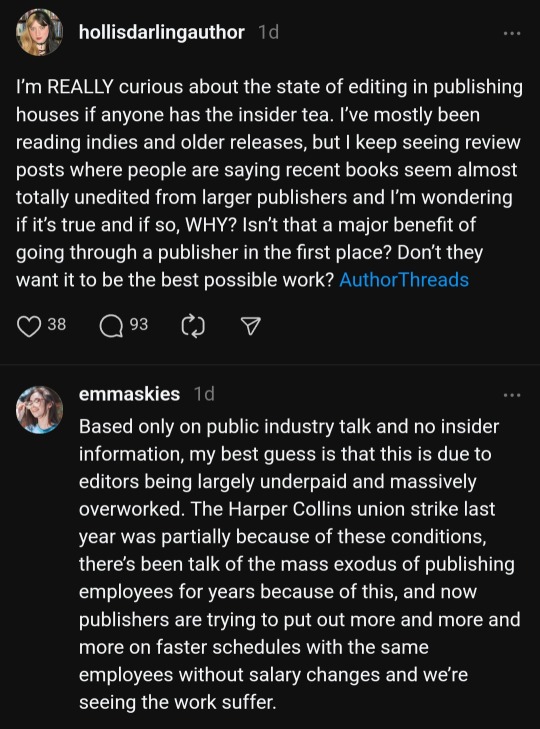
I've been wanting to get into this for awhile, so here we go! First and foremost, I wanna say that "Emmaskies" here is really hitting the nail on the head despite having "no insider info". I don't want this post to be read as me shitting on trad pub editors or authors because that is fundamentally not what's happening.
Second, I want to say that this reply from Aaron Aceves is also spot on:
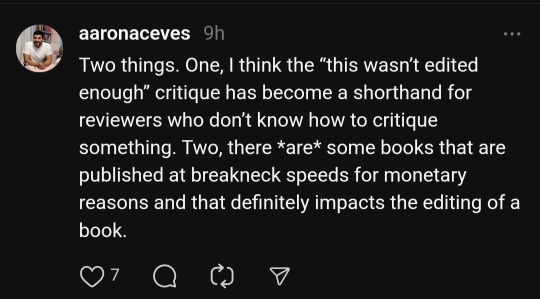
There are a lot of reviewers who think "I didn't enjoy this" means "no one edited this because if someone edited it, they would have made it something I like". As I talk about nonstop on this account, that is not a legitimate critique. However, as Aaron also mentions, rushed books are a thing that also happens.
As an author with 2 trad pub novels and 2 trad pub anthologies (all with HarperCollins, the 2nd largest trad publisher in the country), let me tell you that if you think books seem less edited lately, you are not making that up! It's true! Obviously, there are still a sizeable number of books that are being edited well, but something I was talking about before is that you can't really know that from picking it up. Unlike where you can generally tell an indie book will be poorly edited if the cover art is unprofessional or there are typoes all over the cover copy, trad is broken up into different departments, so even if editorial was too overworked to get a decent edit letter churned out, that doesn't mean marketing will be weak.
One person said that some publishers put more money into marketing than editorial and that's why this is happening, but I fundamentally disagree because many of these books that are getting rushed out are not getting a whole lot by way of marketing either! And I will say that I think most authors are afraid to admit if their book was rushed out or poorly edited because they don't want to sabotage their books, but guess what? I'm fucking shameless. Café Con Lychee was a rush job! That book was poorly edited! And it shows! Where Meet Cute Diary got 3 drafts from me and my beta readers, another 2 drafts with me and my agent, and then another 2 drafts with me and my editor, Café Con Lychee got a *single* concrete edit round with my editor after I turned in what was essentially a first draft. I had *three weeks* to rewrite the book before we went to copy edits. And the thing is, this wasn't my fault. I knew the book needed more work, but I wasn't allowed more time with it. My editor was so overworked, she was emailing me my edit letter at 1am. The publisher didn't care if the book was good, and then they were upset that its sales weren't as high at MCD's, but bffr. A book that doesn't live up to its potential is not going to sell at the same rate as one that does!
And this may sound like a fluke, but it's not. I'm not naming names because this is a deeply personal thing to share, but I have heard from *many* authors who were not happy with their second books. Not because they didn't love the story but because they felt so rushed either with their initial drafts or their edits that they didn't feel like it lived up to their potential. I also know of authors who demanded extra time because they knew their books weren't there yet only to face big backlash from their publisher or agent.
I literally cannot stress to you enough that publisher's *do not give a fuck* about how good their products are. If they can trick you into buying a poorly edited book with an AI cover that they undercut the author for, that is *better* than wasting time and money paying authors and editors to put together a quality product. And that's before we get into the blatant abuse that happens at these publishers and why there have been mass exoduses from Big 5 publishers lately.
There's also a problem where publishers do not value their experienced staff. They're laying off so many skilled, dedicated, long-term committed editors like their work never meant anything. And as someone who did freelance sensitivity reading for the Big 5, I can tell you that the way they treat freelancers is *also* abysmal. I was almost always given half the time I asked for and paid at less than *half* of my general going rate. Authors publishing out of their own pockets could afford my rate, but apparently multi-billion dollar corporations couldn't. Copy edits and proofreads are often handled by freelancers, meaning these are people who aren't familiar with the author's voice and often give feedback that doesn't account for that, plus they're not people who are gonna be as invested in the book, even before the bad payment and ridiculous timelines.
So, anyway, 1. go easy on authors and editors when you can. Most of us have 0 say in being in this position and authors who are in breech of their contract by refusing to turn in a book on time can face major legal and financial ramifications. 2. Know that this isn't in your head. If you disagree with the choices a book makes, that's probably just a disagreement, but if you feel like it had so much potential but just *didn't reach it*, that's likely because the author didn't have time to revise it or the editor didn't have time to give the sort of thorough edits it needed. 3. READ INDIE!!! Find the indie authors putting in the work the Big 5's won't do and support them! Stop counting on exploitative mega-corporations to do work they have no intention of doing.
Finally, to all my readers who read Café Con Lychee and loved it, thank you. I love y'all, and I appreciate y'all, and I really wish I'd been given the chance to give y'all the book you deserved. I hope I can make it up to you in 2025.
5K notes
·
View notes
Text
Had a few folks interested in how I made the patches I posted for Solarpunk Aesthetic Week, so I thought I'd give y'all my step-by-step process for making hand-embroidered patches!
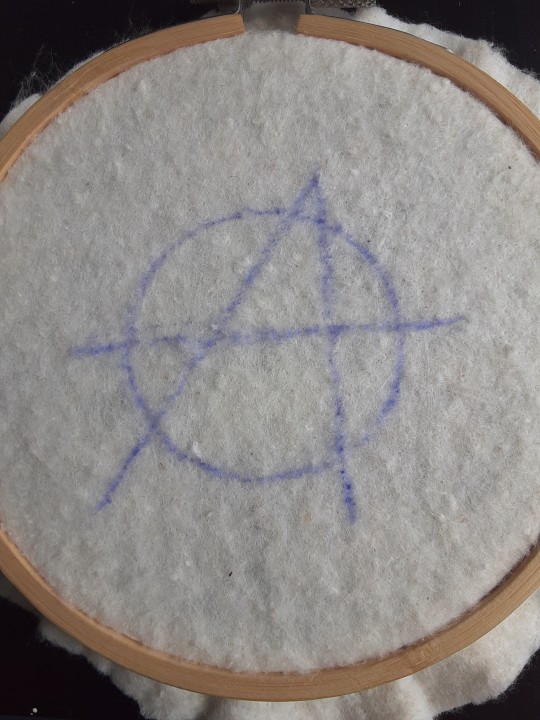
First, choose your fabric and draw on your design. You can use basically any fabric for this - for this project I'm using some felt I've had lying around in my stash for ages.
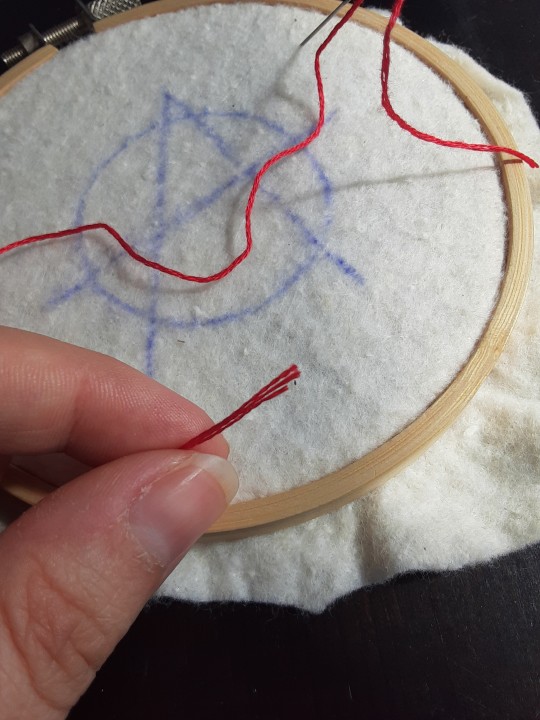
Next, choose your embroidery floss. For my patches I split my embroidery floss into two threads with 3 strands each, as pictured. You can use as many strands in your thread as you prefer, but for the main body of my patches I prefer 3 strands.
Next you're going to start filling your design using a back stitch.
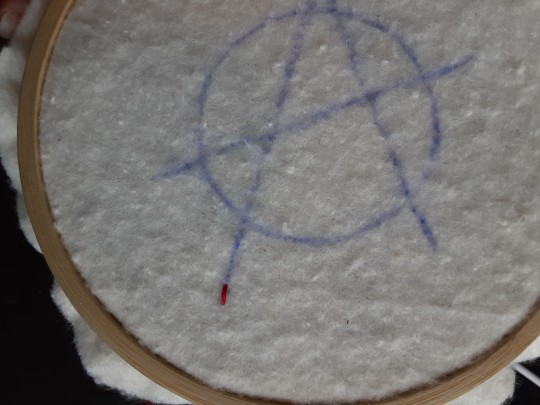
First, put in a single stitch where you want your row to start.
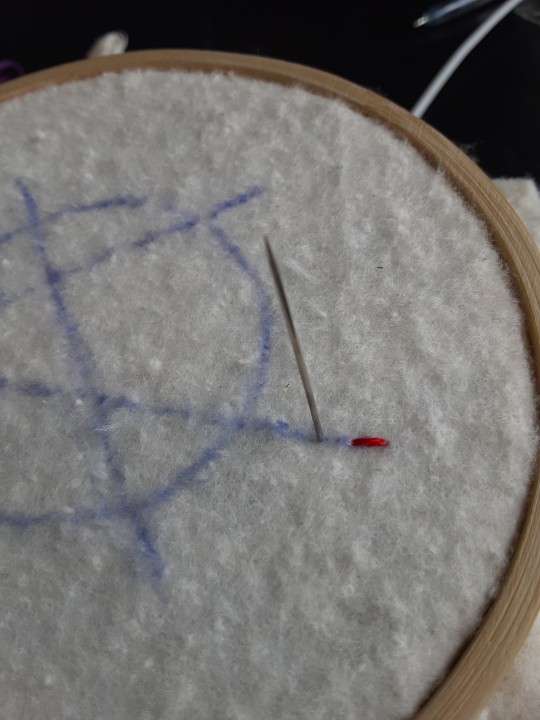
Poke your needle up through the fabric 1 stitch-length away from your first stitch.
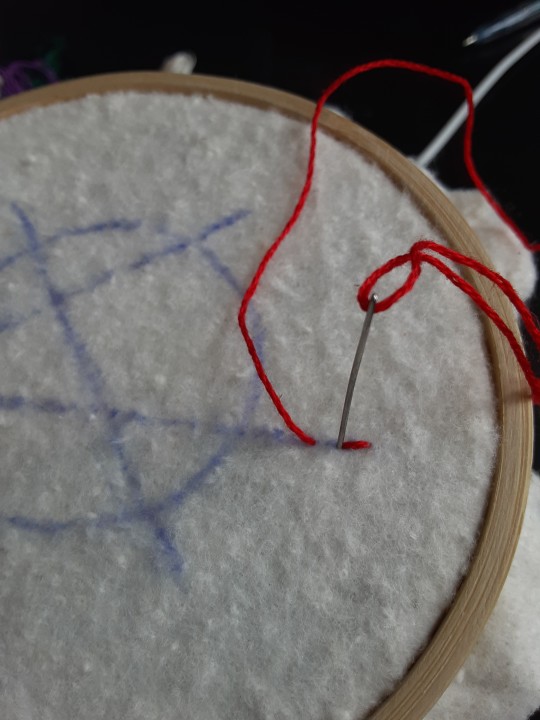
Poke your needle back down the same hole your last stitch went into so they line up end-to-end.
Repeat until you have a row of your desired length (usually the length of that colour section from one end to the other). Once you have your first row, you're going to do your next row slightly offset from your first row so that your stitches lay together in a brick pattern like this:
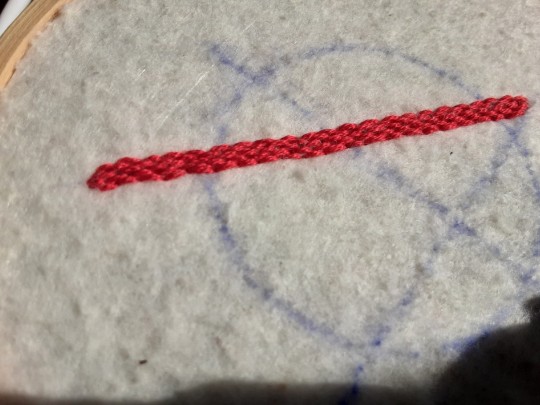
Make sure your rows of stitches are tight together, or you'll get gaps where the fabric shows through.
Rinse and repeat with rows of back stitch to fill in your patch design.
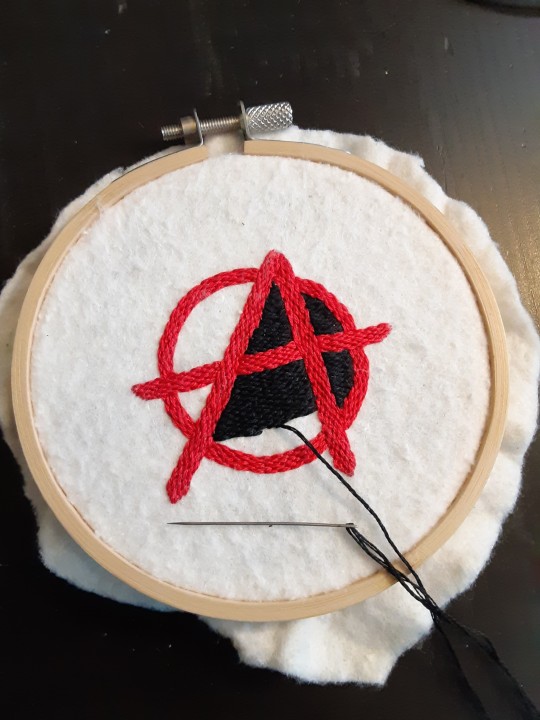
When you're almost to the end of your thread, poke your needle through to the back of the fabric and pull the thread under the back part of the stitching to tuck in the end. Don't worry if it looks messy - no one's gonna see the back anyway.
This next step is fully optional, but I think it makes the patch design really pop. Once your patch is filled in, you can use black embroidery floss to outline your design (or whatever colour you want to outline with - it's your patch, do what you want). I use the full thread (6 strands, not split) of embroidery floss to make a thicker outline.
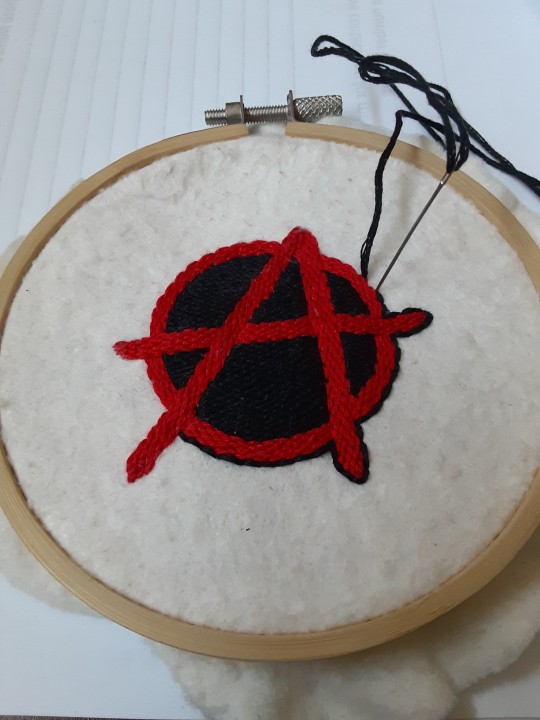
I use the same back stitch I used to fill the piece to make an outline that adds some separation and detail. You could use most any 'outlining' stitch for this, but I just use back stitch because it's just easier for me to do.
Once you're finished embroidering your patch, it's time to cut it out!
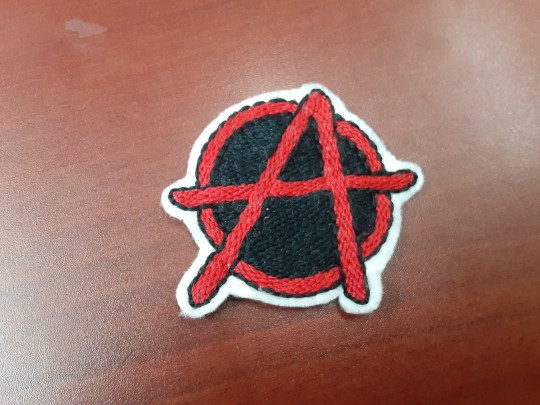
Make sure to leave a little border around the edge to use for sewing your patch on your jacket/bag/blanket/whatever, and be careful not to accidentally cut through the stitches on the back of the patch.
If you have a sturdy enough fabric that isn't going to fray, you can just leave it like this. If not, I recommend using a whip stitch/satin stitch to seal in the exposed edges (I find that splitting your embroidery floss into 3-strand threads works best for this).
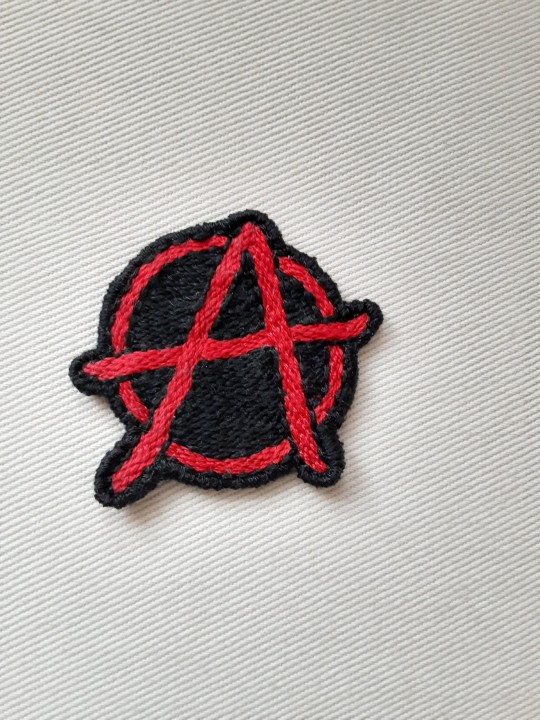
And then you're done! At this point you can put on iron-on backing if you want, or just sew it on whatever you wanna put it on. Making patches this way does take a long time, but I feel that the results are worth it.
Thanks for reading this tutorial! I hope it was helpful. If anyone makes patches using this method, I'd love to see them! 😁
#solarpunk aesthetic week#sewing#tutorial#sew on patch#punk diy#diy punk#punk aesthetic#handmade#solarpunk#handcrafted#embroidery#embroidered patch#how to#how to make a patch
18K notes
·
View notes
Text

Tumblr’s Core Product Strategy
Here at Tumblr, we’ve been working hard on reorganizing how we work in a bid to gain more users. A larger user base means a more sustainable company, and means we get to stick around and do this thing with you all a bit longer. What follows is the strategy we're using to accomplish the goal of user growth. The @labs group has published a bit already, but this is bigger. We’re publishing it publicly for the first time, in an effort to work more transparently with all of you in the Tumblr community. This strategy provides guidance amid limited resources, allowing our teams to focus on specific key areas to ensure Tumblr’s future.
The Diagnosis
In order for Tumblr to grow, we need to fix the core experience that makes Tumblr a useful place for users. The underlying problem is that Tumblr is not easy to use. Historically, we have expected users to curate their feeds and lean into curating their experience. But this expectation introduces friction to the user experience and only serves a small portion of our audience.
Tumblr’s competitive advantage lies in its unique content and vibrant communities. As the forerunner of internet culture, Tumblr encompasses a wide range of interests, such as entertainment, art, gaming, fandom, fashion, and music. People come to Tumblr to immerse themselves in this culture, making it essential for us to ensure a seamless connection between people and content.
To guarantee Tumblr’s continued success, we’ve got to prioritize fostering that seamless connection between people and content. This involves attracting and retaining new users and creators, nurturing their growth, and encouraging frequent engagement with the platform.
Our Guiding Principles
To enhance Tumblr’s usability, we must address these core guiding principles.
Expand the ways new users can discover and sign up for Tumblr.
Provide high-quality content with every app launch.
Facilitate easier user participation in conversations.
Retain and grow our creator base.
Create patterns that encourage users to keep returning to Tumblr.
Improve the platform’s performance, stability, and quality.
Below is a deep dive into each of these principles.
Principle 1: Expand the ways new users can discover and sign up for Tumblr.
Tumblr has a “top of the funnel” issue in converting non-users into engaged logged-in users. We also have not invested in industry standard SEO practices to ensure a robust top of the funnel. The referral traffic that we do get from external sources is dispersed across different pages with inconsistent user experiences, which results in a missed opportunity to convert these users into regular Tumblr users. For example, users from search engines often land on pages within the blog network and blog view—where there isn’t much of a reason to sign up.
We need to experiment with logged-out tumblr.com to ensure we are capturing the highest potential conversion rate for visitors into sign-ups and log-ins. We might want to explore showing the potential future user the full breadth of content that Tumblr has to offer on our logged-out pages. We want people to be able to easily understand the potential behind Tumblr without having to navigate multiple tabs and pages to figure it out. Our current logged-out explore page does very little to help users understand “what is Tumblr.” which is a missed opportunity to get people excited about joining the site.
Actions & Next Steps
Improving Tumblr’s search engine optimization (SEO) practices to be in line with industry standards.
Experiment with logged out tumblr.com to achieve the highest conversion rate for sign-ups and log-ins, explore ways for visitors to “get” Tumblr and entice them to sign up.
Principle 2: Provide high-quality content with every app launch.
We need to ensure the highest quality user experience by presenting fresh and relevant content tailored to the user’s diverse interests during each session. If the user has a bad content experience, the fault lies with the product.
The default position should always be that the user does not know how to navigate the application. Additionally, we need to ensure that when people search for content related to their interests, it is easily accessible without any confusing limitations or unexpected roadblocks in their journey.
Being a 15-year-old brand is tough because the brand carries the baggage of a person’s preconceived impressions of Tumblr. On average, a user only sees 25 posts per session, so the first 25 posts have to convey the value of Tumblr: it is a vibrant community with lots of untapped potential. We never want to leave the user believing that Tumblr is a place that is stale and not relevant.
Actions & Next Steps
Deliver great content each time the app is opened.
Make it easier for users to understand where the vibrant communities on Tumblr are.
Improve our algorithmic ranking capabilities across all feeds.
Principle 3: Facilitate easier user participation in conversations.
Part of Tumblr’s charm lies in its capacity to showcase the evolution of conversations and the clever remarks found within reblog chains and replies. Engaging in these discussions should be enjoyable and effortless.
Unfortunately, the current way that conversations work on Tumblr across replies and reblogs is confusing for new users. The limitations around engaging with individual reblogs, replies only applying to the original post, and the inability to easily follow threaded conversations make it difficult for users to join the conversation.
Actions & Next Steps
Address the confusion within replies and reblogs.
Improve the conversational posting features around replies and reblogs.
Allow engagements on individual replies and reblogs.
Make it easier for users to follow the various conversation paths within a reblog thread.
Remove clutter in the conversation by collapsing reblog threads.
Explore the feasibility of removing duplicate reblogs within a user’s Following feed.
Principle 4: Retain and grow our creator base.
Creators are essential to the Tumblr community. However, we haven’t always had a consistent and coordinated effort around retaining, nurturing, and growing our creator base.
Being a new creator on Tumblr can be intimidating, with a high likelihood of leaving or disappointment upon sharing creations without receiving engagement or feedback. We need to ensure that we have the expected creator tools and foster the rewarding feedback loops that keep creators around and enable them to thrive.
The lack of feedback stems from the outdated decision to only show content from followed blogs on the main dashboard feed (“Following”), perpetuating a cycle where popular blogs continue to gain more visibility at the expense of helping new creators. To address this, we need to prioritize supporting and nurturing the growth of new creators on the platform.
It is also imperative that creators, like everyone on Tumblr, feel safe and in control of their experience. Whether it be an ask from the community or engagement on a post, being successful on Tumblr should never feel like a punishing experience.
Actions & Next Steps
Get creators’ new content in front of people who are interested in it.
Improve the feedback loop for creators, incentivizing them to continue posting.
Build mechanisms to protect creators from being spammed by notifications when they go viral.
Expand ways to co-create content, such as by adding the capability to embed Tumblr links in posts.
Principle 5: Create patterns that encourage users to keep returning to Tumblr.
Push notifications and emails are essential tools to increase user engagement, improve user retention, and facilitate content discovery. Our strategy of reaching out to you, the user, should be well-coordinated across product, commercial, and marketing teams.
Our messaging strategy needs to be personalized and adapt to a user’s shifting interests. Our messages should keep users in the know on the latest activity in their community, as well as keeping Tumblr top of mind as the place to go for witty takes and remixes of the latest shows and real-life events.
Most importantly, our messages should be thoughtful and should never come across as spammy.
Actions & Next Steps
Conduct an audit of our messaging strategy.
Address the issue of notifications getting too noisy; throttle, collapse or mute notifications where necessary.
Identify opportunities for personalization within our email messages.
Test what the right daily push notification limit is.
Send emails when a user has push notifications switched off.
Principle 6: Performance, stability and quality.
The stability and performance of our mobile apps have declined. There is a large backlog of production issues, with more bugs created than resolved over the last 300 days. If this continues, roughly one new unresolved production issue will be created every two days. Apps and backend systems that work well and don't crash are the foundation of a great Tumblr experience. Improving performance, stability, and quality will help us achieve sustainable operations for Tumblr.
Improve performance and stability: deliver crash-free, responsive, and fast-loading apps on Android, iOS, and web.
Improve quality: deliver the highest quality Tumblr experience to our users.
Move faster: provide APIs and services to unblock core product initiatives and launch new features coming out of Labs.
Conclusion
Our mission has always been to empower the world’s creators. We are wholly committed to ensuring Tumblr evolves in a way that supports our current users while improving areas that attract new creators, artists, and users. You deserve a digital home that works for you. You deserve the best tools and features to connect with your communities on a platform that prioritizes the easy discoverability of high-quality content. This is an invigorating time for Tumblr, and we couldn’t be more excited about our current strategy.
#joining the other people in the notes saying I'll leave if you force algorithmic suggestions into my following feed#I agree that there should be a way to promote new artists but this ain't it#one of the reasons I've had a harder time engaging with artists lately is the new way posts are displayed when you click on the header#because they no longer show you the post on the user's page#so clicking their art tag takes you to global search instead of that user's art#and that sucks!#means people are less likely to look at the rest of their stuff and less likely to follow#and instead get dumped in a global 'my art' tag FULL of stuff they don't care about and shut it immediately#engagement fail#the replies are a mess though please do improve that#reblogs seem fine?#if you add push notifications I can't opt out of I will simply block all notifications at the phone os level#and mark emails as spam#this should be optional#also please make collapsing reblog threads optional#and don't remove multiple reblogs from different users from our dashes!!!!!#the tag commentary is the lifeblood of the community here ffs#I want to see the tags from each person without having to dig through the notes and try and find if a mutual reblogged it 250 reblogs ago#on that note how about letting use filter the notes tab so we can see stuff from people we follow#you're not going to get the tiktok kids interested in this site and if you try you're going to lose what you have#try catering to the artists leaving twitter#but without trying to be twitter#because twitter SUCKS for finding art#and seeing older art from the same person#I only use it to follow artists who aren't on here#and I only look in the following tab and searches#maybe try asking the artist community how they'd like to see their stuff boosted?#because a lot of them are on here being unhappy about the non-chrono dash too#tumblr stuff#oh hey also this post just showed me it's really hard to go to the original post if the op has a ton of checkmarks
65K notes
·
View notes
Text
I have recently received another ask about my canvas pulling and since I've been thinking about making a serious tutorial for a while now, I took the opportunity to take some pics and vids while finishing the tree. Do please enjoy :3
1. Why pulling out canvas at all?
Primarily, this is a fantastic technique to apply cross stitch patterns directly to the item you want OR to make patches from old jeans, like this one:
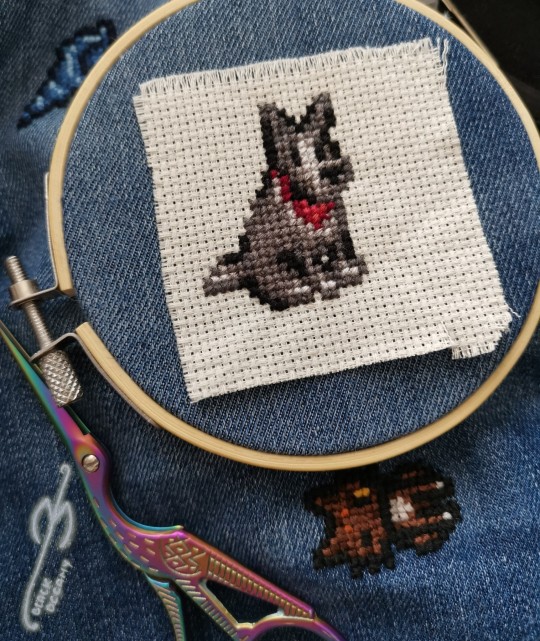
With small patterns I usually don't bother to sew the canvas prior to embroidering, like with the pupper above. In case of the bigger patterns, I usually sew it lightly on the edges just to keep the canvas in one place. The more stretchy the material type is, the more important it's going to be to keep it in place.
2. Why not use a soluble canvas?
I'm sure you can and that they'll be as successful as the regular one 😁 However, as I mentioned in my previous posts here and here, I prefer to err on the side of cheaper, hence the tutorial.
3. Okay. I'm convinced - I even have a pattern embroidered on! What's next?
With small patterns (like the doggo earlier) it's going to be pretty easy. You just pull the threads one by one - preferably starting on the thinnest part of the pattern - and you may not even need the pliers. The fun (?) is with the large pieces, because the canvas has on average quite fragile threads and they like to break. Note - the canvas I'm using and I suppose most of the existing canvas types, will have four threads per one embroidery row. It's usually easier to pull one first and then the other three, bit that may vary when, for example, you managed to pierce the thread during stitching phase earlier 😉
If you were already careful during the stitching, you paid extra attention to embroider EXACTLY between the canvas threads and avoid piercing them at all. There are two benefits to that being extra careful: one, it's easier to pull it out later; two, the stitching gains an extra precision to it (and it looks great!). I recently discover that the round tip needle is making it much easier and if you're interested, there's a separate post about it as well!
On to the process! You can see from the pictures how I started with cutting out a piece of canvas that I can later reuse for something small (recycling is my hobby 🤷🏻♀️). I also pulled loose threads from around the tree:

Next part was to clean up the trunk and the grass on the right:

I then cut off the excess to avoid the threads tangling and slowly moved to the sides of the leaves on right and left:
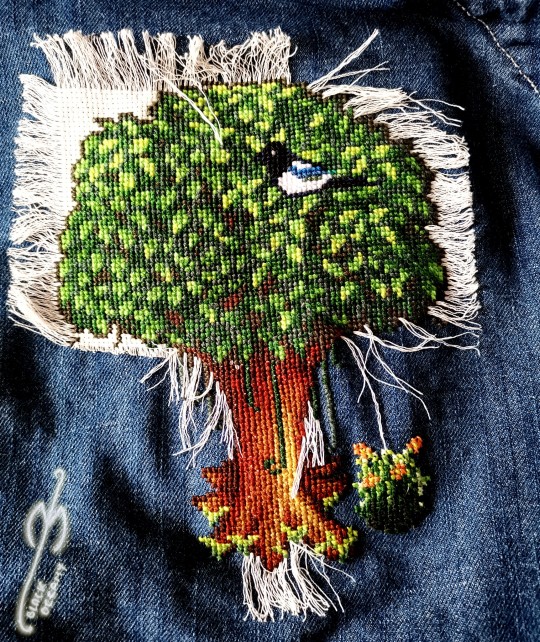
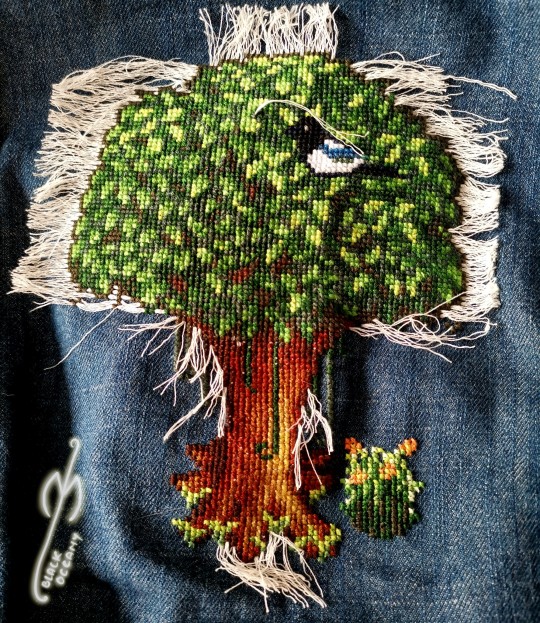
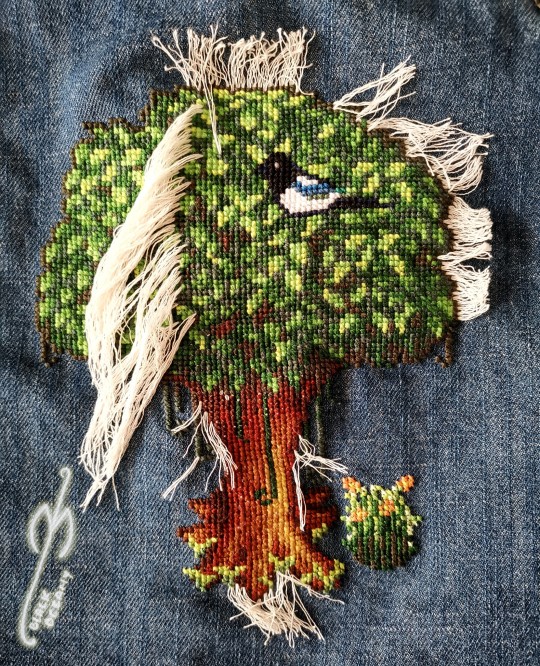
You'll notice that the last photo has the thread pulled halfway through the pattern. That's because on this stage it's usually impossible to simply pull the thread out - even with the pliers it is just going to break off. I use a needle to pluck it from between the embroidery like this:
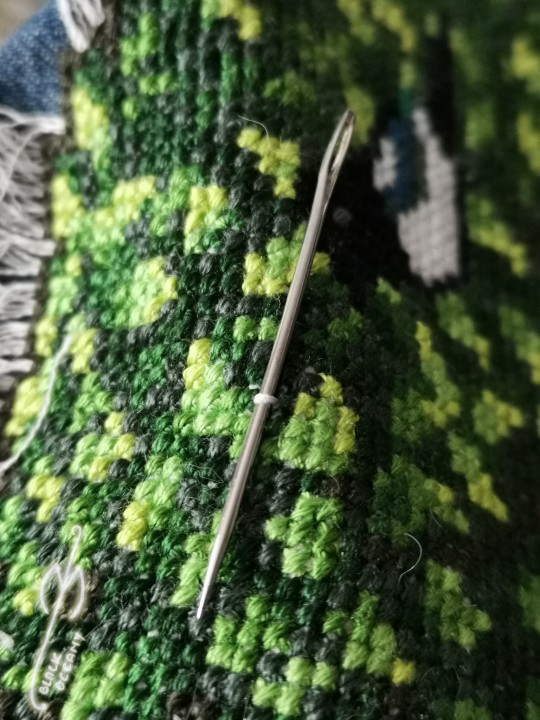
If you're more of the visual learner, I made this vid that I hope explains the process in more detail. You'll notice that I'm using my fingers and not the pliers here, because it's faster than to switch between tools.
And finally, when you're left with single direction threads like these, it's just a matter of pulling them out one by one.
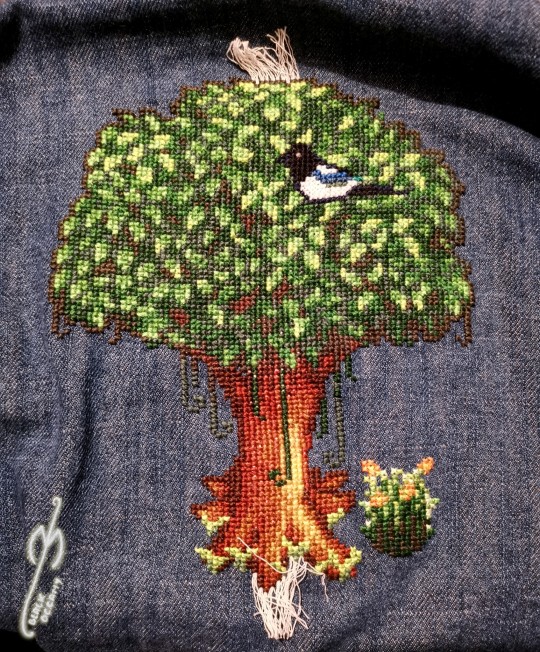
And that's it! The final product looks clean and neat, AND you will notice that without the canvas beneath it's also getting a bit of volume that looks cool (and helps even out small mistakes you may have made along the way).

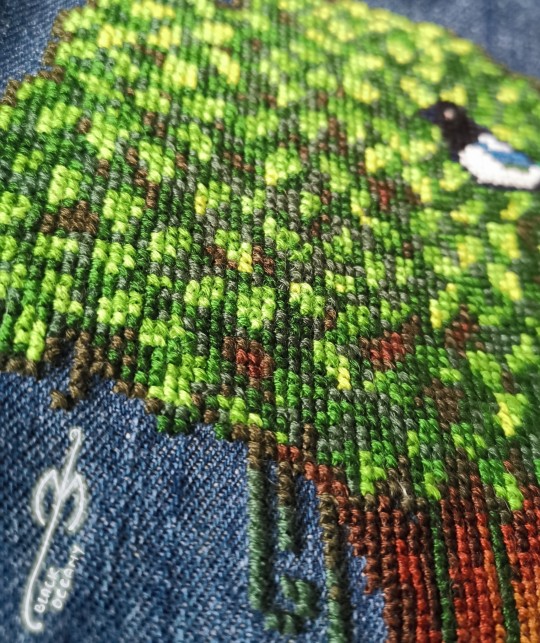
Thanks for reading this far! Let me know if there's something else I forgot to explain 😊
1K notes
·
View notes
Text
Predicting the present

If you'd like an essay-formatted version of this post to read or share, here's a link to it on pluralistic.net, my surveillance-free, ad-free, tracker-free blog:
https://pluralistic.net/2024/12/09/radicalized/#deny-defend-depose

Back in 2018, around the time I emailed my immigration lawyer about applying for US citizenship, I started work on a short story called "Radicalized," which eventually became the title story of a collection that came out in 2019:
https://us.macmillan.com/books/9781250228598/radicalized/
"Radicalized" is a story about America, and about guns, and about health care, and about violence. I live in Burbank, which is ranks second in gun-stores-per-capita in the USA, a dubious honor that represents a kind of regulatory arbitrage with our neighboring goliath, the City of Los Angeles, where gun store licensing is extremely tight. If you're an Angeleno in search of a firearm, you're almost certainly coming to Burbank to buy it.
Walking, cycling and driving past more gun stores than I'd ever seen in my Canadian life got me thinking about Americans and guns, a subject that many Canadians have passed comment upon. Americans kill each other, and especially themselves, at rates that baffle everyone else in the world, and they do it with guns. When we moved here, my UK born-and-raised daughter came home from her first elementary school lockdown drill perplexed and worried. Knowing what I did about US gun violence, I understood that while school shootings and other spree killings happened with dismal and terrifying regularity, they only accounted for a small percentage of the gun deaths here. If you die with a bullet in you, the chances are that the finger on the trigger was your own. The next most likely suspect is someone you know. After that, a cop. Getting shot by a stranger out of uniform is something of a rarity here – albeit a spectacular one that captures our imaginations in ways that deliberate or accidental self-slayings and related-party shootings do not.
So I told her, "Look, you can basically ignore everything they tell you during those lockdown drills, because they almost certainly have nothing to do with your future. But if a friend ever says to you, 'Hey, wanna see my dad's gun?' I want you to turn around and leave and get in touch with me right away, that instant."
Guns turn the murderous impulse – which, let's be honest, we've all felt at some time or another – into a murderous act. Same goes for suicide, which explains the high levels of non-accidental self-shootings in the USA: when you've got a gun, the distance between suicidal ideation and your death is the ten feet from the sofa to the gun in the closet.
Americans get angry at people and then, if they have a gun to hand, sometimes they shoot them. In a thread /r/Burbank about how people at our local cinemas are rude and use their phones in which someone posted, "Well, you should just ask them to stop." The reply: "That's a great way to get shot." No one chimed in to say, "Don't be ridiculous, no one would shoot you for asking them to put away their phone during a movie." Same goes for "road rage."
And while Americans shoot people they've only just gotten angry at, they also sometimes plan shooting sprees and kill a bunch of people because they're just generically angry. Being angry about the state of the world is a completely relatable emotion, of course, but the targets of these shootings are arbitrary. Sure sometimes these killings have clear, bigoted targets – mass shootings at Black supermarkets or mosques or synagogues or gay bars – more often the people who get sprayed with bullets (at country and western concerts or elementary schools or movie theaters) are almost certainly not the people the gunman (almost always a man) is angry at.
This line of thought kept surfacing as I went through the immigration process, but not just when I was dealing with immigration paperwork. I was also spending an incredible amount of time dealing with our health insurer, Cigna, who kept refusing treatments my pain doctor – one of the most-cited pain researchers in the country – thought I would benefit from. I've had chronic pain since I was a teenager, and it's only ever gotten worse. I've had decades of pain care in Canada and the UK, and while the treatments never worked for very long, it was never compounded by the kinds of bureaucratic stuff I went through with my US insurer.
The multi-hour phone calls with Cigna that went nowhere would often have me seeing red – literally, a red tinge closing in around my vision – and usually my hands would be shaking by the time I got off the call.
And I had it easy! I wasn't terminally ill, and I certainly wasn't calling in on behalf of a child or a spouse or parent who was seriously ill or dying, whose care was being denied by their insurer. Bernie's 2016 Medicare For All campaign promise had filled the air with statistics (Americans pay more for care and get worse outcomes than anyone else in the rich world), and stories. So many stories – stories that just tore your heart out, about parents who literally had to watch their children die because the insurance they paid for refused to treat their kids. As a dad, I literally couldn't imagine how I'd cope in that situation. Just thinking about it filled me with rage.
One day, as I was swimming in the community pool across the street – a critical part of my pain management strategy – I was struck with a thought: "Why don't these people murder health insurance executives?" Not that I wanted them to. I don't want anyone to kill anyone. But why do American men who murder their wives and the people who cut them off in traffic and random classrooms full of children leave the health insurance industry alone? This is an industry that is practically designed to fill the people who interact with it with uncontrollable rage. I mean, if you're watching your wife or your kid die before your eyes because some millionaire CEO decided to aim for a $10 billion stock buyback this year instead of his customary $9 billion target, wouldn't you feel that kind of murderous rage?
Around this time, my parents came out for a visit from Canada. It was a great trip, until one night, my mom woke me up after midnight: "We have to take your father to the ER. He's really sick." He was: shaking, nauseated, feverish. We raced down the street to the local hospital, part of a gigantic chain that has swallowed nearly all the doctors' practices, labs and hospitals within an hour's drive of here.
Dad had kidney stones, and they'd gone septic. When the ER docs removed the stones, all the septic gunk in his kidneys was flushed into his bloodstream, and he crashed. If he hadn't been in an ER recovery room at the time, he would have died. As it was, he was in a coma for three days and it was touch and go. My brother flew down from Toronto, not sure if this was his last chance to see our dad alive. The nurses and doctors took great care of my dad, though, and three days later, he emerged from his coma, and today, he's better than ever.
But on day two, when we thought he was probably at the end of his life, as my mother sat at his side, holding the hand of her husband of fifty years, someone from the hospital billing department came to her side and said, "Mrs Doctorow, I know this is a difficult time, but I'd like to discuss the matter of your husband's bill with you."
The bill was $176,000. Thankfully, the travel medical insurance plan offered by the Ontario Teachers' Union pension covered it all (I don't suppose anyone gets very angry with them).
How do people tolerate this? Again, not in the sense of "people should commit violent acts in the face of these provocations," but rather, "How is it that in a country filled with both assault rifles and unimaginable acts of murderous cruelty committed by fantastically wealthy corporations, people don't leap from their murderous impulses to their murderous weapons to commit murderous acts?
For me, writing fiction is an accretive process. I can tell that a story is brewing when thoughts start rattling around in my mind, resurfacing at odd times. I think of them as stray atoms, seeking molecules with available docking sites to glom onto. I process all my emotions – but especially my negative ones – through this process, by writing stories and novels. I could tell that something was cooking, but it was missing an ingredient.
Then I found it: an interview with the woman who coined the term "incel." It was on the Reply All podcast, and Alana, a queer Canadian woman explained that she had struggled all her life to find romantic and sexual partnership, and jokingly started referring to herself as "involuntarily celibate," and then, as an "incel":
https://gimletmedia.com/shows/reply-all/76h59o
Alana started a message board where other "incels" could offer each other support, and it was remarkably successful. The incels on Alana's message board helped each other work through the problems that stood between them and love, and when they did, they drifted away from the board to pursue a happier life.
That was the problem, Alana explained. If you're in a support group for people with a drinking problem, the group elders, the ones who've been around forever, are the people who've figured it out and gotten sober. When life seems impossible, those elders step in to tell you, I know it's terrible right now, but it'll get better. I was where you are and I got through it. You will, too. I'm here for you. We all are.
But on Alana's incel board, the old timers were the people who couldn't figure it out. They were the ones for whom mutual support and advice didn't help them figure out what they needed to do in order to find the love they sought. The longer the message board ran, the more it became dominated by people who were convinced that it was hopeless, that love was impossible for the likes of them. When newbies posted in rage and despair, these Great Old Ones were there to feed it: You're right. It will never get better. It only gets worse. There is no hope.
That was the missing piece. My short story Radicalized was born. It's a story about men on a message board called Fuck Cancer Right In the Fucking Face (FCKRFF, or "Fuckriff"), who are watching the people they love the most in the world be murdered by their insurance companies, who egg each other on to spectacular acts of mass violence against health insurance company employees, hospital billing offices, and other targets of their rage. As of today, anyone can read this story for free, courtesy of my publishers at Macmillan, who gave permission for the good folks at The American Prospect to post it:
https://prospect.org/culture/books/2024-12-09-radicalized-cory-doctorow-story-health-care/
I often hear from people about this story, even before an unknown (at the time of writing) man assassinated Brian Thompson, CEO of Unitedhealthcare, the murderous health insurance monopoly that is the largest medical insurer in the USA. Since then, hundreds of people have gotten in touch with me to ask me how I feel about this turn of events, how it feels to have "predicted" this.
I've been thinking about it for a few days now, and I gotta tell you, I have complicated feelings.
You've doubtless seen the outpourings of sarcastic graveyard humor about Thompson's murder. People hate Unitedhealthcare, for good reason, because he personally decided – or approved – countless policies that killed people by cheating them until they died.
Nurses and doctors hate Thompson and United. United kills people, for money. During the most acute phase of the pandemic, the company charged the US government $11,000 for each $8 covid test:
https://pluralistic.net/2020/09/06/137300-pct-markup/#137300-pct-markup
UHC leads the nation in claims denials, with a denial rate of 32% (!!). If you want to understand how the US can spend 20% of its GDP and get the worst health outcomes in the world, just connect the dots between those two facts: the largest health insurer in human history charges the government a 183,300% markup on covid tests and also denies a third of its claims.
UHC is a vertically integrated, murdering health profiteer. They bought Optum, the largest pharmacy benefit manager ("A spreadsheet with political power" -Matt Stoller) in the country. Then they starved Optum of IT investment in order to give more money to their shareholders. Then Optum was hacked by ransomware gang and no one could get their prescriptions for weeks. This killed people:
https://www.economicliberties.us/press-release/malicious-threat-actor-accesses-unitedhealth-groups-monopolistic-data-exchange-harming-patients-and-pharmacists/#
The irony is, Optum is terrible even when it's not hacked. The purpose of Optum is to make you pay more for pharmaceuticals. If that's more than you can afford, you die. Optum – that is, UHC – kills people:
https://pluralistic.net/2024/09/23/shield-of-boringness/#some-men-rob-you-with-a-fountain-pen
Optum isn't the only murderous UHC division. Take Navihealth, an algorithm that United uses to kick people out of their hospital beds even if they're so frail, sick or injured they can't stand or walk. Doctors and nurses routinely watch their gravely ill patients get thrown out of their hospitals. Many die. UHC kills them, for money:
https://prospect.org/health/2024-08-16-steward-bankruptcy-physicians-private-equity/
The patients murdered by Navihealth are on Medicare Advantage. Medicare is the public health care system the USA extends to old people. Medicare Advantage is a privatized system you can swap your Medicare coverage for, and UHC leads the country in Medicare Advantage, blitzing seniors with deceptive ads that trick them into signing up for UHC Medicare Advantage. Seniors who do this lose access to their doctors and specialists, have to pay hundreds or thousands of dollars for their medication, and get hit with $400 surprise bills to use the "free" ambulance service:
https://prospect.org/health/2024-12-05-manhattan-medicare-murder-mystery/
No wonder the public spends 22% more subsidizing Medicare Advantage than they spend on the care for seniors who stick with actual Medicare:
https://theconversation.com/taxpayers-spend-22-more-per-patient-to-support-medicare-advantage-the-private-alternative-to-medicare-that-promised-to-cost-less-241997
It's not just the elderly, it's also the addicted and mentally ill. UHC illegally denies coverage for mental health and substance abuse treatment. Imagine watching a family member spiral out of control, ODing, or ending up on the streets with hallucinations, and knowing that the health insurance company that takes thousands of dollars out of your paycheck refused to treat them:
https://www.startribune.com/unitedhealthcare-will-pay-15-7m-in-settlement-of-denial-of-care-charges/600087607
Unsurprising, the internal culture at UHC is callous beyond belief. How could it not be? How could you go to work at UHC and know you were killing people and not dehumanize those victims? A lawsuit by chronically ill patient whom UHC had denied care for surfaced recorded phone calls in which UHC employees laughed long and hard about the denied claims, dismissing the patient's desperate, tearful pleas as "tantrums" :
https://www.propublica.org/article/unitedhealth-healthcare-insurance-denial-ulcerative-colitis
Those UHC workers are just trying to get by, of course, and the callouses they develop so they can bear to go to work were ripped off by last week's murder. UHC's executive team knows this, and has gone on a rampage to stop employees from leaking their own horror stories, or even mentioning that the internal company announcement of Thompson's death was seen by 16,000 employees, of whom only 28 left a comment:
https://www.kenklippenstein.com/p/unitedhealthcare-tells-employees
Doctors and nurses hate UHC on behalf of their patients, but it's also personal. UHC screws doctor's practices by refusing to pay them, making them chase payments for months or even years, and then it offers them a payday lending service that helps them keep the lights on while they wait to get paid:
https://www.youtube.com/watch?v=frr4wuvAB6U
Is it any surprise that Reddit's nursing forums are full of nurses making grim, satisfied jokes about the assassination of the $10m/year CEO who ran the $400b/year corporation that does all this?
https://www.thedailybeast.com/leading-medical-subreddit-deletes-thread-on-unitedhealthcare-ceos-murder-after-users-slam-his-record/
We're not supposed to experience – much less express – schadenfreude when someone is murdered in the street, no matter who they are. We're meant to express horror at the idea of political violence, even when that violence only claims a single life, a fraction of the body count UCH produced under Thompson's direction. As Malcolm Harris put it, "'Every life is precious' stuff about a healthcare CEO whose company is noted for denying coverage is pretty silly":
https://twitter.com/BigMeanInternet/status/1864471932386623753
As Woody Guthrie wrote, "Some will rob you with a six-gun/And some with a fountain pen." The weapon is lethal when it's a pistol and when it's an insurance company. The insurance company merely serves as an accountability sink, a layer of indirection that lets a murder happen without any person being the technical murderer:
https://profilebooks.com/work/the-unaccountability-machine/
I don't want people to kill insurance executives, and I don't want insurance executives to kill people. But I am unsurprised that this happened. Indeed, I'm surprised that it took so long. It should not be controversial to note that if you run an institution that makes people furious, they will eventually become furious with you. This is the entire pitch of Thomas Piketty's Capital in the 21st Century: that wealth concentration leads to corruption, which is destabilizing, and in the long run it's cheaper to run a fair society than it is to pay for the guards you'll need to keep the guillotines off your lawn:
https://memex.craphound.com/2014/06/24/thomas-pikettys-capital-in-the-21st-century/
But we've spent the past 40 years running in the other direction, maximizing monopolies, inequality and corruption, and gaslighting the public when they insist that this is monstrous and unfair. Back in 2022, when UHC was buying Change Healthcare – the dominant payment network for hospitals, which would allow UHC to surveil all its competitors' payments – the DOJ sued to block the merger. The Trump-appointed judge in the case, Carl Nichols – who owned tens of thousands of dollars in UHC bonds – ruled against the DOJ, saying that it would all be fine thanks to United's "culture of trust and integrity":
https://www.thebignewsletter.com/p/the-antitrust-shooting-war-has-started
We don't know much about Thompson's killer yet, but he's already becoming a folk hero, with lookalike contests in NYC:
https://twitter.com/CollinRugg/status/1865472577478553976
And gigantic graffiti murals praising him and reproducing the words he wrote on the shell casings of the bullets he used to kill Thompson, "delay, deny, depose":
https://www.tumblr.com/radicalgraff/769193188403675136/killin-fuckin-ceos-freight-graff-in-the-bay
I get why this is distasteful. Thompson is said to have been a "family man" who loved his kids, and I have no reason to disbelieve this. I can only imagine that his wife and kids are shattered by this. Every living person is the apex of a massive project involving dozens, hundreds of people who personally worked to raise, nurture and love them. I wrote about this in my novel Walkaway, as the characters consider whether to execute a mercenary sent to kill them, whom they have taken hostage:
She had parents. People who loved her. Every human was a hyper-dense node of intense emotional and material investment. Speaking meant someone had spent thousands of hours cooing to you. Those lean muscles, the ringing tone of command — their inputs were from all over the world, carefully administered. The merc was more than a person: like a spaceship launch, her existence implied thousands of skilled people, generations of experts, wars, treaties, scholarship and supply-chain management. Every one of them was all that.
But so often, the formula for "folk hero" is "killing + time." The person who terrorizes the people who terrorize you is your hero, and eventually we sanitize the deaths, and just remember them as fighters for justice. If you doubt it, consider the legend of Robin Hood:
https://twitter.com/mcmansionhell/status/1865554985842352501
The health industry is trying to put a lid on this, palpably afraid that – as in my story "Radicalized" – this one murderer will become a folk hero who inspires others to acts of spectacular violence. They're insisting that it's unseemly to gloat about Thompson's death. They're right, but this is an obvious loser strategy. The health industry is full of people whose deaths would be deplorable, but not unsurprising. As Clarence Darrow had it:
I’ve never wished a man dead, but I have read some obituaries with great pleasure.
Murder is never the answer. Murder is not a healthy response to corruption. But it is healthy for people to fear that if they kill people for greed, they will be unsafe. On December 5 – the day after Thompson's killing – the health insurer Anthem announced that it would not pay for anesthesia for medical procedures that ran long. The next day, they retracted the policy, citing "outrage":
https://www.cnn.com/2024/12/05/health/anthem-blue-cross-blue-shield-anesthesia-claim-limits/index.html
Sure, maybe it was their fear of reputation damage that got them to decide to reverse this inhumane, disgusting, murderous policy. But maybe it was also someone in the C-suite thinking about what share of the profits from this policy would have to be spent on additional bodyguards for every Anthem exec if it went into effect, and decided that it was a money-loser after all.
Think about hospital exec Ralph de la Torre, who cheerfully testified to Congress that he'd killed patients in pursuit of profit. De la Torre clearly doesn't fear any kind of consequences for his actions. He owns hospitals that are filled with tens of thousands of bats (he stiffed the exterminators), where none of the elevators work (he stiffed the repair techs), where there's no medicine or blood (he stiffed the suppliers) and where the doctors and nurses can't make rent (he stiffed them too). De La Torre doesn't just own hospitals – he also owns a pair of superyachts:
https://pluralistic.net/2024/02/28/5000-bats/#charnel-house
It is a miracle that so many people have lost their mothers, sons, wives and husbands so Ralph de la Torre could buy himself another superyacht, and that those people live in a country where you can buy an assault rifle, and that Ralph de la Torre isn't forced to live in a bunker and travel in a tank.
It's a rather beautiful sort of miracle, to be honest. I like to think that it comes from a widespread belief by the people of this country I have since become a citizen of, that we should solve our problems politically, rather than with bullets.
But the assassination of Brian Thompson is a wake-up call, a warning that if we don't solve this problem politically, we may not have a choice about whether it's solved with violence. As a character in "Radicalized" says, "They say violence never solves anything, but to quote The Onion: that's only true so long as you ignore all of human history":
https://prospect.org/culture/books/2024-12-09-radicalized-cory-doctorow-story-health-care/
#pluralistic#unitedhealthcare#assassination#execution#violence#murder#science fiction#radicalized#health insurance#m4a#medicare for all#Brian Thompson#guns#cancer#corruption#usausausa#torment nexus
1K notes
·
View notes
Text
"Saw traps for people with moral OCD" is a phrase that has embedded myself into my brain because, well, Saw traps for people with moral OCD are everywhere.
Stuff that basically amounts to...
"You have to listen to my opinions on [issue], or else you don't care about [issue]. (Constantly talks about how people like you are the absolute worst.)"
Anything that's functionally like, "you have to let me tear you down over things you can't control or you're a bad person."
Anything that's functionally like, "you have to let me vent to you whenever and however I want or else you're a bad person."
"If you enjoy X media/trope, you just hate Y people."
"Everyone knows that X thing is harmful/hateful; if you engaged in it, it's just because you were fine with perpetuating hate/harm."
"You should have just known better/should know this already!"
This thread over here talks about the inherent issues of putting this kind of stuff out there. The TL;DR is that it really only works on people who are mentally unwell and have poor boundaries, while just pissing off everyone else. It really doesn't matter if you're technically correct; you're still attacking people, and that means they're not wrong to block you.
I think that many of these Saw traps are created when people effectively write posts directed toward people who don't want to help, rather than the ones who do. Like, if you catch yourself writing an angry, shame-laden post, ask yourself: who are you writing it for and what are the odds you're going to change their minds? If your mental image is some smug fuck or angry reactionary, you're writing for the wrong person. Write for the person who's curious, who's willing to learn.
Also? Work on figuring out how to transmute negative feelings into positive, encouraging rhetoric. EG:
"Why is there no X positivity?" -> "Let's hear it for X!"
"No one cares about Y problem!" -> "Hey, we need more recognition of Y problem" or "I haven't seen many people talking about Y problem, so here's some info on what's up."
"If you don't reblog this, you don't care about [group]" -> "Please reblog this, it would mean a lot for us [group]."
And if you're really super duper frustrated and want to vent with a lot of nasty words and sentiments? Consider taking it to a private vent channel or a journal or somewhere that a stranger with moral OCD/scrupulosity isn't likely to run across it.
Remember, most people don't want to hurt anyone. More people are ignorant than malicious. People naturally want to do the right thing, so if you feel like you have to guilt them or shame them into it, there's probably a fundamental communication issue somewhere, or they simply lack the context to understand why what you're saying is so important.
#moral ocd#mental health#mental illness#ableism#scrupulosity#scrupulosity ocd#abuse#emotional abuse#communication
9K notes
·
View notes
Text
Why can't people like a celebrity without imagine them as queer? Can't people like Taylor music without go saying she's lesbian/queer when she hasn't said anything about that. Pretty sure if she was attracted to women she would have already said it 🫠
Even in the hypothetical scenario where she was queer indeed pressuring somebody to come out or out them yourself is selfish, stupid, dangerous, toxic and overall fucked up (-᷅_-᷄)
We have so many queer pop icons out of the closet but you need to headcanon your favourite ally/het as lgbt for...comfort reasons? Just because she's your fav? Because you are queer? Dude she's not a fictional character can you not spread false information or discuss real people orientations and just enjoy their content 💀
all goofing aside I genuinely don't understand the urge to reimagine Taylor Allison Swift as a secretly queer icon when the pop music scene(TM) is like. literally overflowing with women who actually like women. Gaga and Kesha and Miley and Halsey are right there. Rina Sawayama and Hayley Kiyoko and Rebecca Black and Kehlani and Victoria Monét and Miya Folick if you're willing to get slightly less top 100. Janelle and Demi for them nonbinary takes on liking girls. like what are we doing here. like I'm not even saying you can't enjoy Taylor but why would you hang all your little gay hopes on her.
#saying this as bi myself btw#WHO SAYS LADY GAGA DOESN'T COUNT AS QUEER JUST BECAUSE SHE'S A BOY KISSER TOO#i'm tired of this shit#please remember that is LGBT+ NOT LGT+#bi/pan folks exist. No need to act like people is either gay or straight and there's no in between when that's clearly *false*!#And even if you aren't lgbt+ I think having this opinion of not giving real people hc sexualities/orientations is still valid#you have too much free time if you're wasting it to theorize about somebody private life while ignoring the very much confirmed queer icons#Plus. If you care sm about somebody sexuality to the point if they aren't what you want them to be you get disappointed/upset#rather than caring more about their work which they produced and you supposedly consume as a self-proclaimed fan...#Are you really a fan of them? I don't think so.#A true fan loves them for who they are or what they produce. Not because for who they feel attracted to#Imagine working your way to the top as a musician or whatever career you pursue and your fans grade your worth or their liking to you#based on who you kiss or sleep with or who you don't 💀#feeling like OOP pfp for real#this is exhausting#Idc less about who Lady Gaga kisses. Yeah having her as bi icon was important to me but if tomorrow she decides to come out as smth else#I'll keep listening her music. Because I like her music. And her personality. And some of her outfits. The end#there are many songs made by women/nb who like women iswtg#you don't need to pretend straight people isn't straight in order to like their music or to like them as a person I promise it's okay 🙏#Also what in the actual fuck is that article??? People seriously get paid for writing that? 💀💀💀💀#So sorry for all the shit you must have read in order to need to do this thread OP and afterwards too#ALSO BATMAN NAME based opinion and good taste hell yeah ✨#the you in all this post only goes to those who think like that btw. If you feel offended the problem is on you#how about taking reading comprehension classes before speaking. Some people are in dire need of it#those who believe a bi is less queer icon than a gay one is in my blacklist. If you come to me with that bs I'll block you on sight
342K notes
·
View notes
Text
Today I saw my first Starbucks ad that had careful product placement, no words or obvious promos, and just two people having a good time.
And to that I want to say.
Fuck you Starbucks.
I know what you're doing.
Lost enough money due to supporting Israel that you've finally turned to sneakiness? Your brand suddenly isn't enough to sell? How saddening.
Like I know that brands and businesses do product placement. I know they do ads and promos. I know they do things to show their "customers"(actors) having a good time with their products. That's not just a Starbucks thing.
But what IS a Starbucks thing is the sneaky approach to it now. They were so careful to have the only logos showing being on the cups. It's subtle. And it's definitely on purpose. Trying to get you to crave both the drink and the experience.
BUT HEY.
REMEMBER.
STARBUCKS AIN'T SHIT GUYS.
IT'S BITTER, OVERROASTED COFFEE BEANS IN A CUP COVERED UP WITH ENOUGH SUGAR TO KILL A MAN.
There's no fucking way that you're going to be enjoying yourself while choking down a caramel French toast macchiato that tastes like licking a dirty brick y'all.
Also like. They're supporting genocide, so.
Maybe. Don't fall for the new promos. Okay?
Free Palestine.
EDIT: I have since been informed that the Starbucks brand itself is not complicit in genocide and instead, it is the CEO of Starbucks who is a Zionist. I have since made an apology post for accidentally spreading misinformation in the reblogs and have tagged my sources with evidence. If you can, please do repost that version of this post instead.
I will still be leaving this version of the post (the original) up and unedited, because I do not want to appear as if I am trying to change the narrative in any way or pretending as if what I have said doesn't exist or effect people.
While I am more than a little embarrassed about my initial approach to the subject, I have since learned more proper ways of threading together my thoughts as well as vetting my resources thoroughly. Thank you, and I hope you have a good night/day.
Free Palestine.
#free palestine#free gaza#from the river to the sea palestine will be free#palestine#gaza genocide#save palestine#freedom#gaza#genocide#none of us are free until all of us are free#free rafah#gaza strip#war on gaza#gazaunderattack#palestine genocide#politics#starbucks boycott#boycott israel#boycott starbucks#boycott mcdonalds#boycott
3K notes
·
View notes